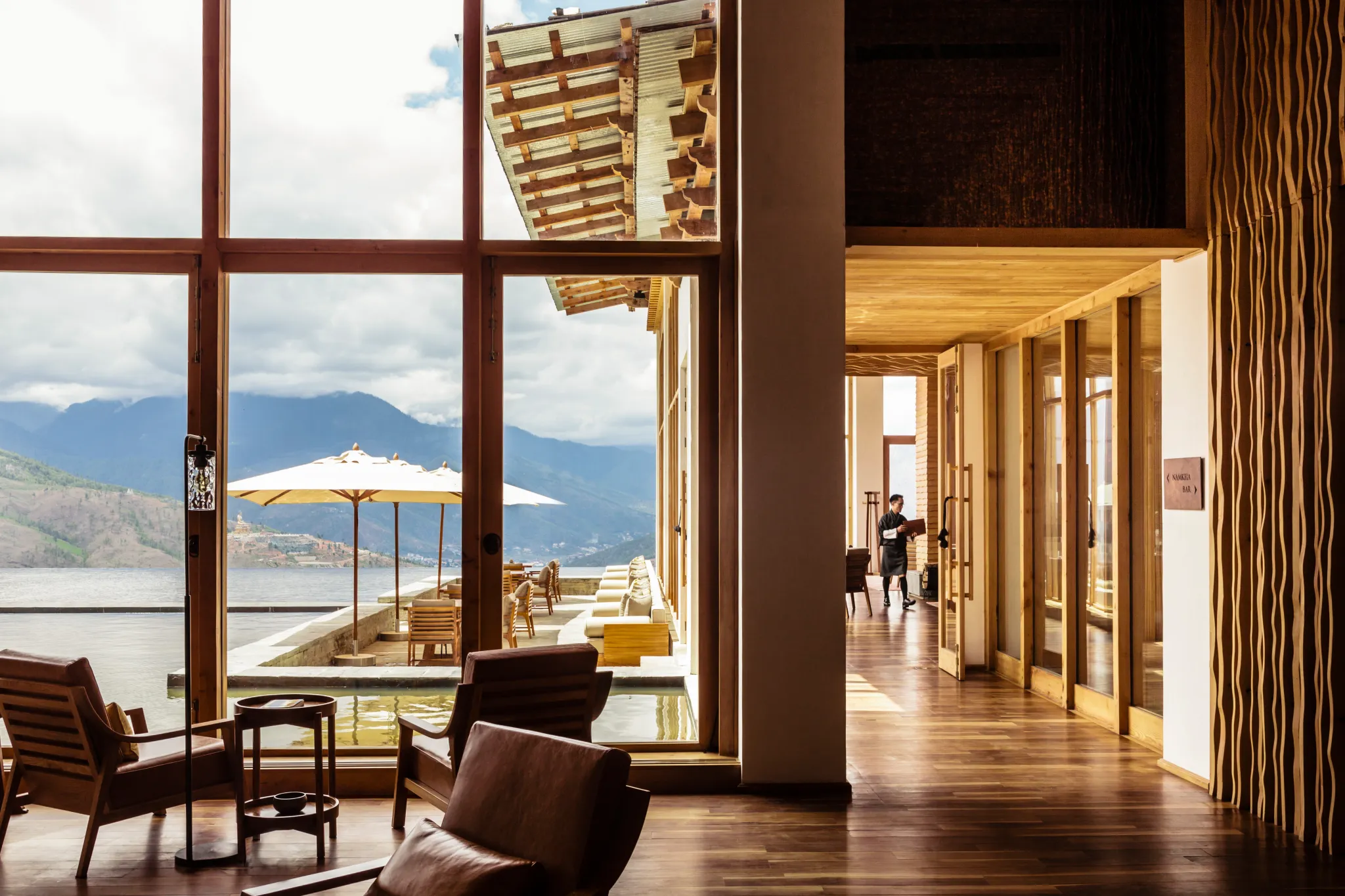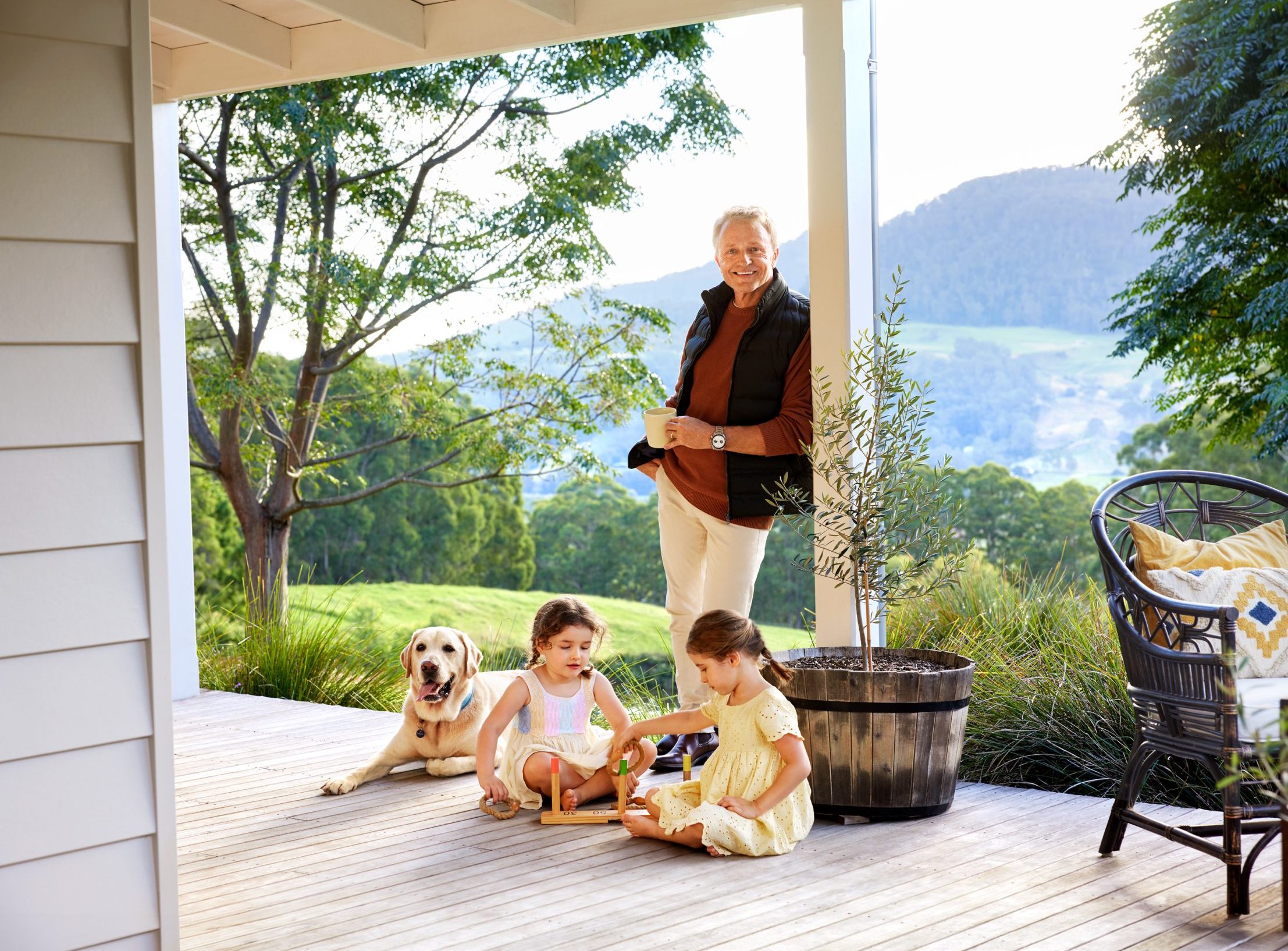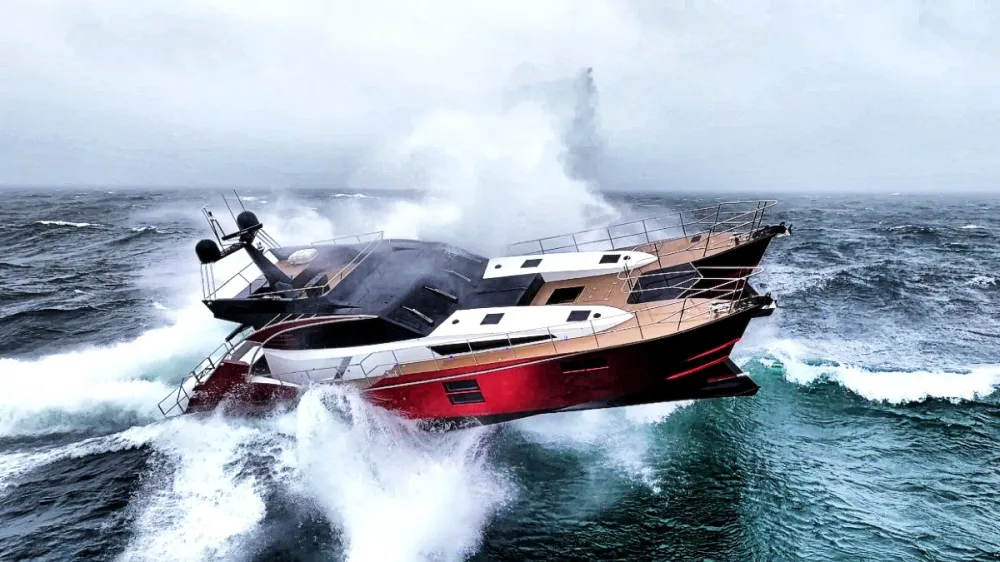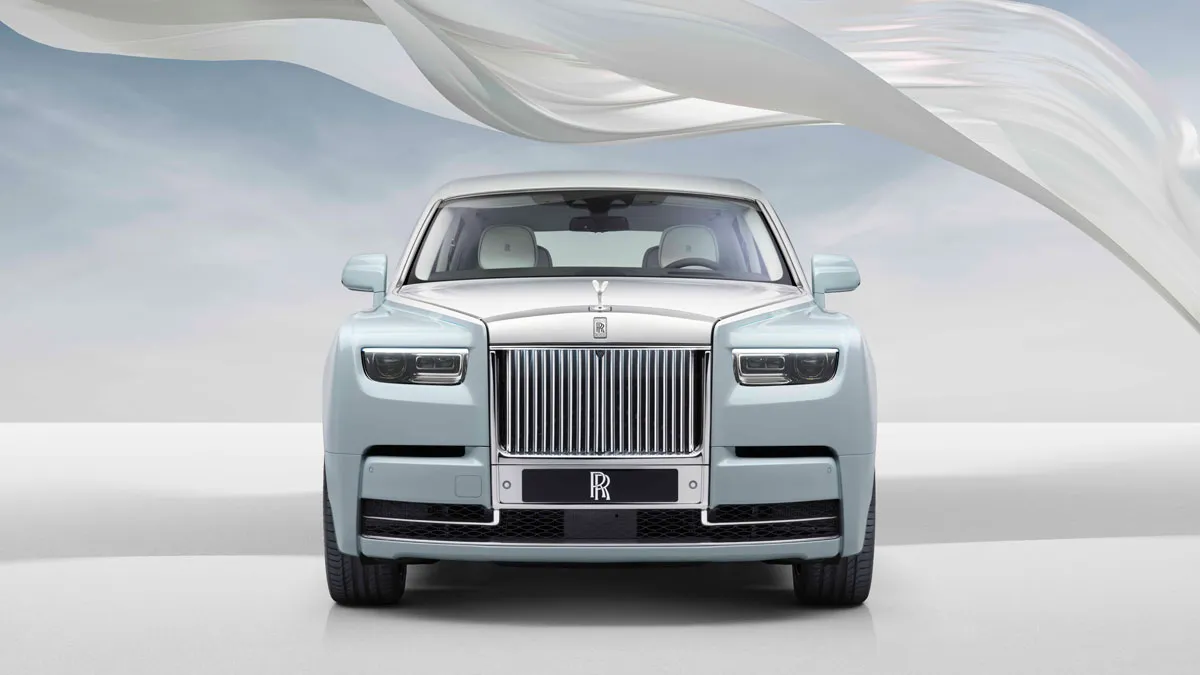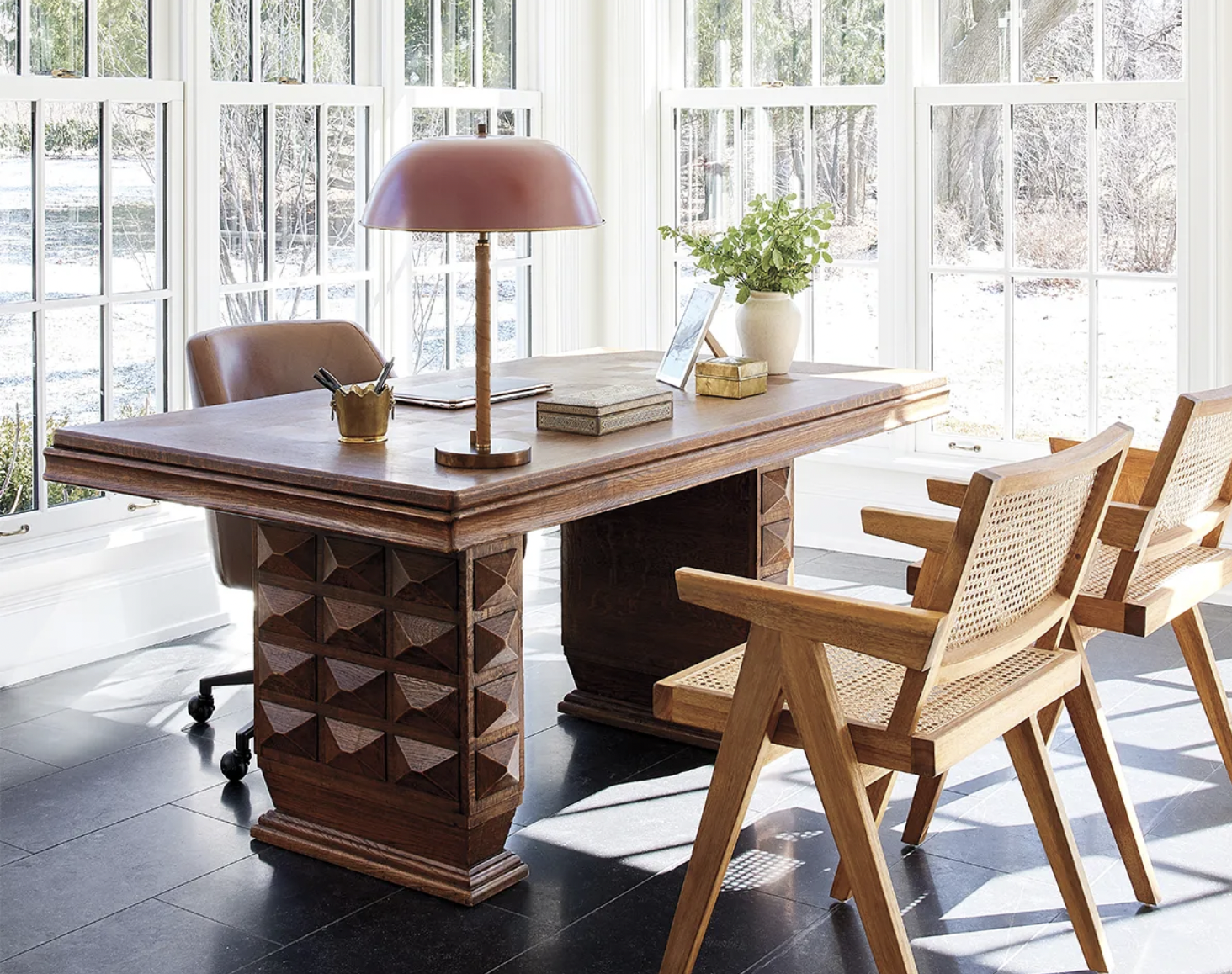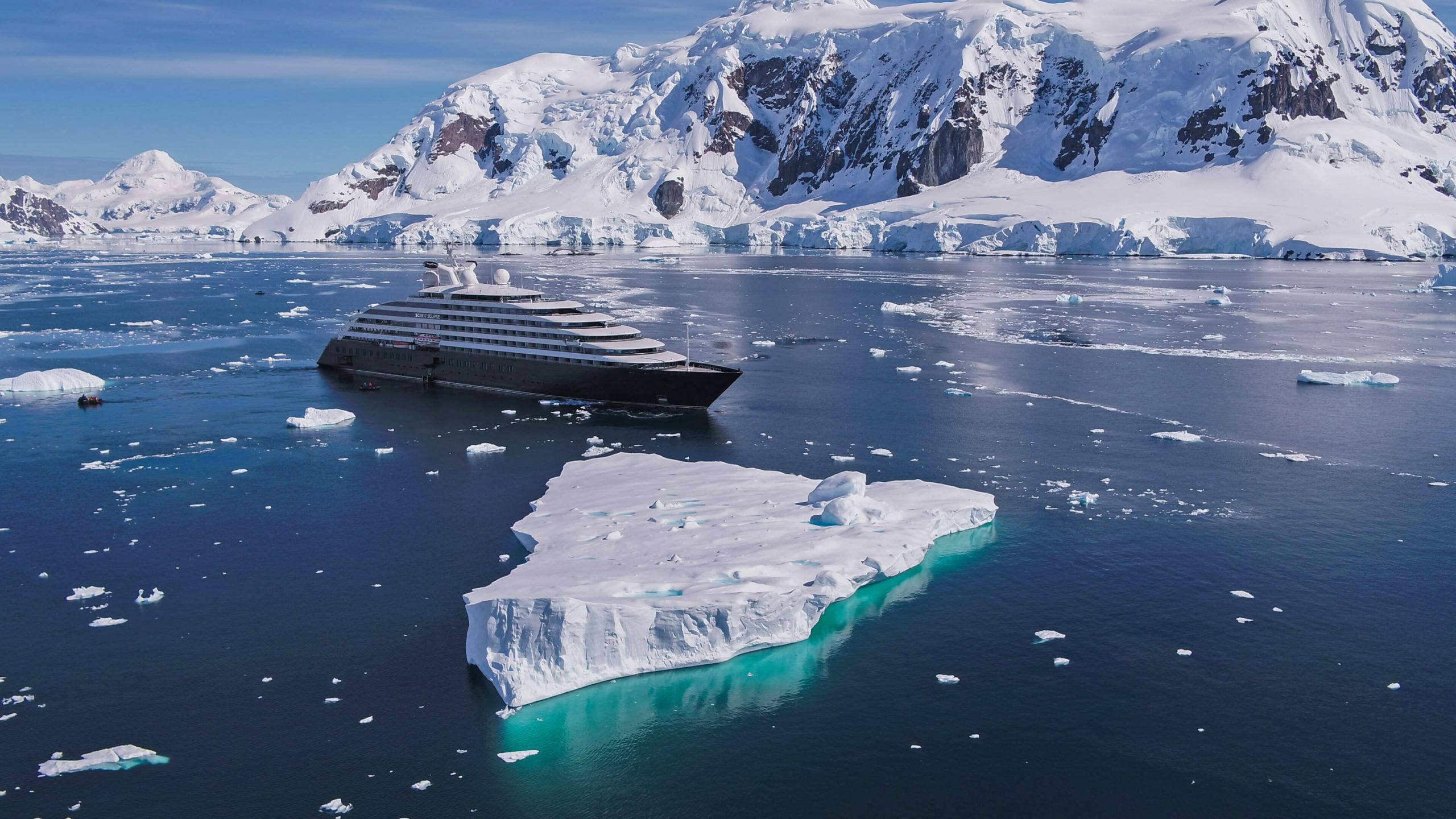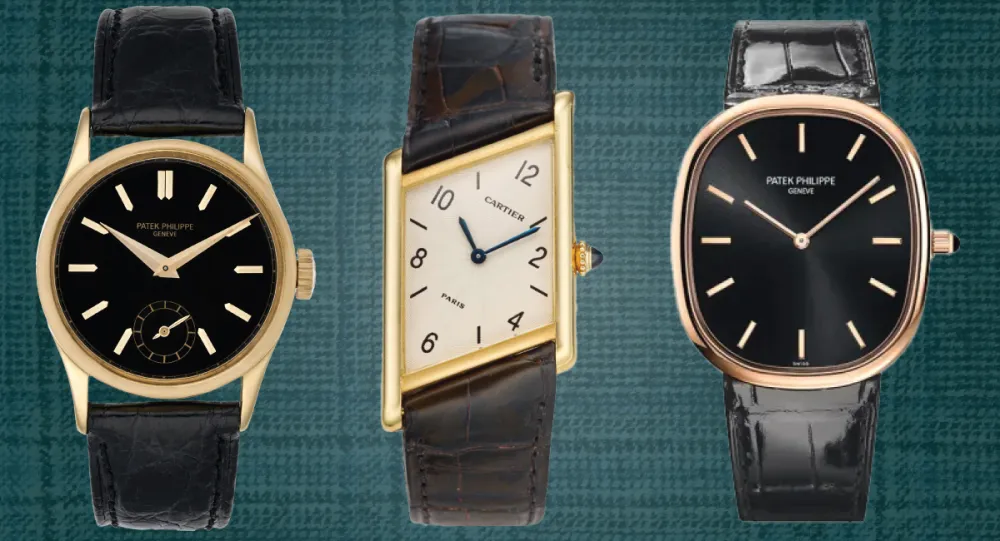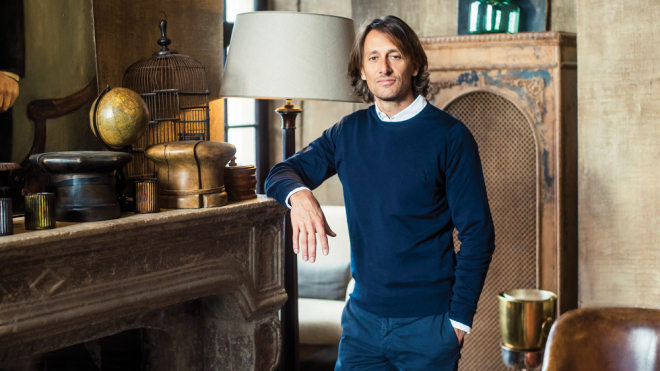
Hotelier Arnaud Zannier on the calming properties of motorcycles and why 45 is the ideal age
The founder of Zannier Hotels talks fast cars, slow fashion, and the freedom of going analogue.
Related articles
Though Arnaud Zannier comes from a family of fashion and wine, his own interests lie in something less tangible: travel. The 45-year-old hotelier—whose father, French businessman Roger Zannier, is known for his ready-to-wear brands and vineyards—opened his first hotel, an exclusive chalet in the Megève, while he was still in his thirties. He has since created a second-generation empire for the Zannier name, with Zannier Hotels properties in Namibia (where he also established a wildlife animal hospital with pal Angelina Jolie), Cambodia, Belgium, and soon Vietnam. Robb Report caught up with the always-exploring entrepreneur on a layover in Bangkok, somewhere around midnight local time, to talk fast bikes, slow fashion, and the freedom of going analogue.
How often do you train?
I have a personal coach that comes to my house at least four times a week at six o’clock in the morning and trains me for an hour. I have a home gym. I’m ageing slowly but surely, but I love sports and I always want to be able to jump at the chance to go golfing or waterskiing at a moment’s notice.
What do you do that’s still analogue?
Read the newspaper. I’m quite classic in certain aspects of life. I like touching the paper; I like the smell of it. There are some things that the digital world can’t replace. Feelings and emotions are very important, and for me digital is killing a lot of that.
What in your wardrobe do you wear most often?
A very good pair of shoes from the brand that I created 15 years ago called NDC. They were very well-made shoes—probably too well-made. And they weren’t about trends at all. They were more classic in terms of technique and using leather from the best Italian tanneries, but had a contemporary twist in the way they were finished. It’s not my brand anymore—I sold it earlier this year—but I still have quite a big stock of my own.
How do you find calm?
I ride my BMW GS on a daily basis. I find it very calming. And working on motorcycles calms me even more. Every winter, I buy an old vintage bike, and I spend the next six months rebuilding. I’ve been doing this for the past five years now, so I have five so far. It’s very meditative to build something.
What song is currently in your head?
Tupac’s “Are U Still Down,” which is a bit bizarre and old-school, but I have been listening to that song a lot lately.
What’s the most recent thing you’ve added to your collection?
It’s a small thing, but I just changed the dial on my Rolex Daytona. I got my first Daytona from my mother for my 20th birthday, and when she passed away last year I decided to start wearing it again. It’s an iconic watch and I wanted to do something with it after owning it for 25 years, so I changed the dial from a white dial to a black dial.

Zannier’s Oomaanda Safari Lodge in Namibia
Photo: Courtesy Zannier Hotels
If you could stick to one age, what would it be, and why?
I like the age that I am at right now. At 45, you reach a certain maturity. You have enough experiences and you also have sharpened your skills, but you’re still young. So you can do anything you want. We’ll see though—maybe 46 is even better.
When was the last time you completely unplugged?
Last weekend for three days while motorbiking in Spain. I was in the mountains north of Barcelona.
What’s your favourite cocktail, and how do you make it?
Whiskey sour. I like it made very classically. A whiskey sour is not a difficult cocktail to make, but having the right balance is not easy. I prefer it made with a beautiful single-malt whiskey.
What’s your dream car?
I’d love to buy a Porsche 911 from my birth year, 1973. I’m actually looking into it at the moment.
What have you done recently for the first time?
I just visited Mexico for the first time for a potential project, and I discovered a beautiful country, with very rich culture. I was in the Pacific Coast visiting a potential site with some investors to create a hotel.
What, apart from more time, would make the biggest difference to your life?
To be able to talk more to my kids without them being on their screens. It makes me crazy the way the younger generations are just so focused on social media.
What apps do you use the most?
Most importantly is probably the phone, and then the next one is email. I’m not a big technology junkie. I’m very simple. If I could drop my phone in the ocean and never look at it again, I would do it.
Do you have any personal rituals?
Fitness in the morning—that’s the only thing I could say that’s a real ritual. My day starts, and it’s off to the office or travelling. This month is mostly travelling. Mexico, Namibia, Asia—all in one month.
What advice do you wish you’d followed?
I can say one: When I started in this business and I was working on the design of my second hotel—my resort in Cambodia—I tried to meet as many people within this industry as possible. I had lunch with Adrian Zecha, the founder of Aman, in Singapore, when I was working on the design of this property, and I asked him, ‘What would you do in terms of number of keys?’ He told me to build 60 rooms, but I was scared that I would not fill the hotel, and it was all so new and felt so big to me, and I didn’t know much about the hotel industry. So I only built 45. Today, the hotel is packed and I wish I had 15 additional rooms. That was good advice that I didn’t follow.
What’s your most annoying quality?
I suppose it could be annoying that I cannot stand still if something that needs to be done hasn’t been not done yet. I have to do it. It is very difficult to rest, and that might be very annoying. Sometimes always being ‘on’ is a quality that gets annoying—even for myself.
What’s your spirit animal?
A dog, they are honest.
Do you have a uniform for certain occasions?
Not really. I change a lot. When I am motorbiking, I wear my rolled denim and my big pair of my boots from my old label NDC. Some days it could be rolled denim, another day a suit, another a smart casual look.
What kind of conversation do you tune out?
None. Anything can be interesting to listen to.
Favourite websites?
Zannier Hotels’ website.
What do you most crave at the end of the day?
A good meal, a good glass of wine, and some rest. When I have had a good hard day at work, I really need rest. Food and wine is very important to me.
Who is your guru?
My father is a very successful businessman so naturally I have learned a lot from him. In my industry, though, I have really been learning from myself, creating my own brand from scratch.
What’s the most impressive dish you cook?
All sorts of eggs in the morning for my ids. I have three kids, and most of the time they all want different eggs. One wants scrambled eggs, the other wants an omelette, the other wants eggs Benedict, so I am a master at cooking eggs.
How do you get to sleep?
I’m tired enough that I don’t need to do anything. I go to bed and I fall straight asleep. I wake up early and work out and work hard. That’s the best routine to help yourself sleep. I don’t go to bed late either.
What does success look like to you?
I think success is when you really enjoy what you do and it makes you happy. That is success.
If you could learn a new skill what would it be?
I would like to be able to play the piano.
How much do you trust your gut instinct?
Quite a lot. When I interview someone I want to recruit, it’s more about feeling and not thinking too much about what is written on paper.
Which are your favourite stores right now?
For fashion, I would say at the moment in Belgium, it’s Frans Boone. They’ve got an incredible selection of small labels and jackets. It’s where I get a lot of my clothes. And I like the Porsche store.
Do you know how many air miles you have?
No idea. I don’t even look at the report when it comes to my office. Because, anyway, you don’t do anything with it. It’s useless. Every time you want to use them, you can’t. You can’t bring your family because it’s never the right time. I don’t even bother with it.
What’s your favourite seat on a plane?
Window.

Next year, Zannier will open Sonop a sister lodge to Oomaanda.
Photo: Courtesy Zannier Hotels
What do you most regret?
Not studying architecture. If I knew I would end up doing what I do, I would have tried to go for architecture. Today, I work a lot on the concept and design of my hotels. I am really into it. If I had some studies in architecture, it would have helped me a lot today.
Drive or be driven?
Drive. I hate being driven.
What are your regular tables in London, New York, or LA?
I try not to have a regular table anywhere. Discovery is part of my job. I am trying to always find new hotels and restaurants and bars, so I try to avoid going to the same places. It’s important to see what’s new.
How many watches do you own?
Too many.
What’s your favourite hotel?
The next Zannier Hotel, because that’s the one my head is into the most. I have been working for more than a year on Sonop (which means sunrise in the Afrikaans). I am so excited to see it. When you work hard on a project and imagine it, you just want to see it finished.
Who do you admire most, and why?
I don’t really admire anybody.
Last piece of advice you gave?
To my youngest son: ‘Stop looking at Instagram, Facebook, and Snapchat!’
The last advice you were given?
It’s too personal to tell you. Sorry.
If you could be anywhere in the world right now, where would you be?
I’m in the middle of an airport in Asia right now and it’s midnight, so home.
What is your email etiquette?
It depends. If it’s internal, I’m short and to the point. And if it’s important people, I will spend a bit more time. But in general, I’m not too formal.
What’s always in your hand luggage?
My laptop.
What’s worth paying for?
Travel.
Wine of choice?
Rosé from my family’s vineyard, Château Saint-Maur, in the St Tropez region.
Do you still write letters?
No.
Movies or theatre?
Movies.
Bowie or Dylan?
David Bowie. Because he’s European! Joking—his music is better.
Subscribe to the Newsletter
Recommended for you
Six Senses Are Suddenly Everywhere. Inside the Luxury Resort’s Growing Global Empire
With 26 properties now open, another 43 to come, and the U.S. square in its sights, the rapidly growing wellness-focused resort and hotel brand is now asking the hard questions
September 3, 2024
You may also like.
You may also like.
This Speedy 70-Foot Power Catamaran Is Designed to Cut Through Rough Waters
The 70-foot T-2000 Voyager can hit 60 mph in flat conditions, and then take waves up to 30 feet.
Back in April, Storm Kathleen slammed into the west coast of Ireland as a fearsome Force 10 gale, packing 112 kph winds and 15-foot waves. While locals sandbagged their homes and prepared for the worst, Frank Kowalski decided it was a swell day for a boat ride.
As owner of Safehaven Marine in County Cork, he’d just launched his brand-new, 70-foot T-2000 Voyager all-weather power catamaran. What Kathleen offered was a chance to put the new super-cat through its paces.
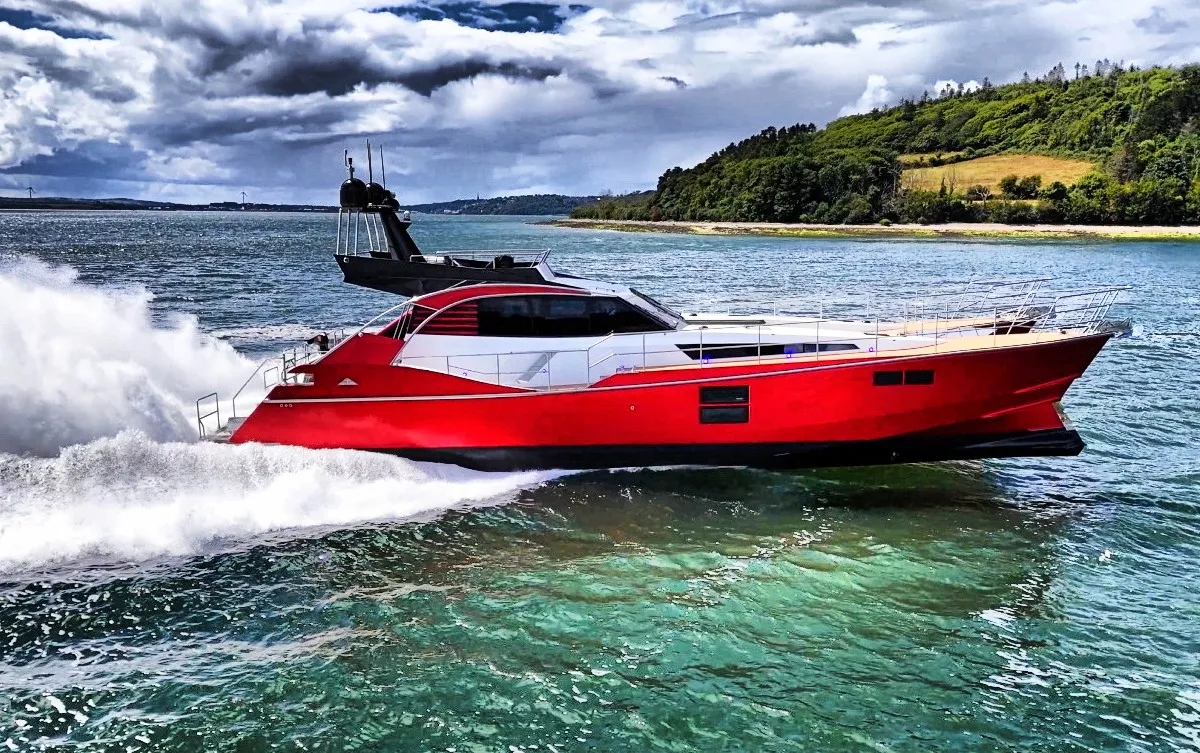
“We knew from scale-model tests that she should be able to tackle waves of more than 65 feet high,” Kowalski tells Robb Report. “But you never know until you’re out there. In the height of the storm, she just shrugged off the waves and weather and performed flawlessly.”
Evolved from Safehaven’s 75-foot XVS20 monohull launched in 2018, Kowalski used his expertise in building commercial, work-boat power catamarans to design the twin-hulled T-2000 Voyager to offer speed with stability.
“The stability in beam seas is what’s key here,” he says. “While we were out recently in a Force 8 with 40-plus knot winds and 12-foot seas, we were able to stop and leave the boat to drift while we retrieved a drone. It just took the waves on the beam with ease. In a monohull, it would have been rolling so badly you couldn’t have stood on the deck.”
Then there’s the sheer velocity that comes with twin, scalpel-thin hulls slicing through waves. With the T-2000’s pair of 1,550 hp MAN V12 diesels driving France Helices SD5 surface drives, the Safehaven can hit a top speed of 91 kph.
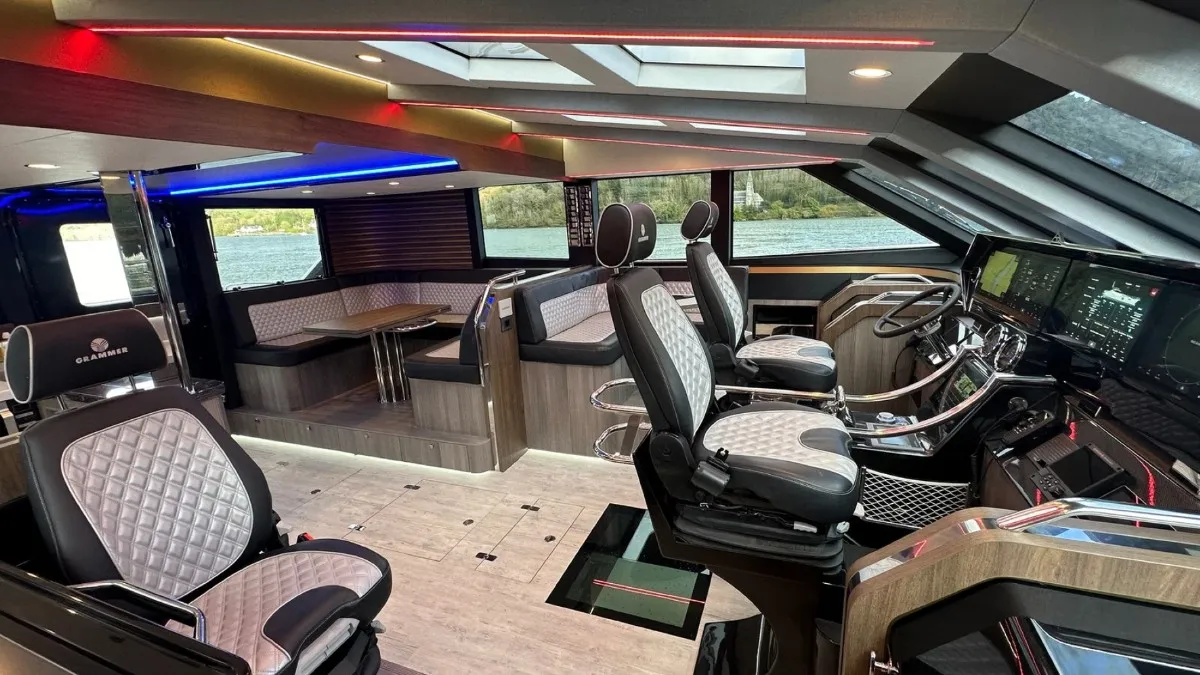
“It’s just the most amazing sight, standing on the stern, watching these huge roostertails behind,” Kowalski adds. “We’ve also incorporated retracting swim platforms so you can see the props spinning on the surface, plus valved exhausts that switch between silenced and straight-through. The noise from those V12s is sensational.”
While Safehaven has been building its Wildcat range of 40-, 53-, and 60-foot power cats for everything from oil-rig support, crew transfer, and even as a military cruiser for Britain’s Royal Navy, they were always pure, no-frills work boats. With this new T-2000, Kowalski is looking to appeal to private buyers searching for something a little different.
His hull No. 1 demonstrator boat has all-diamond-quilted marine leather, well-finished cabinetry, colored LED lighting, and below-deck accommodations for six in three cabins. Hull No. 2—already sold and due for completion in the next 18 months—will up the luxury factor.
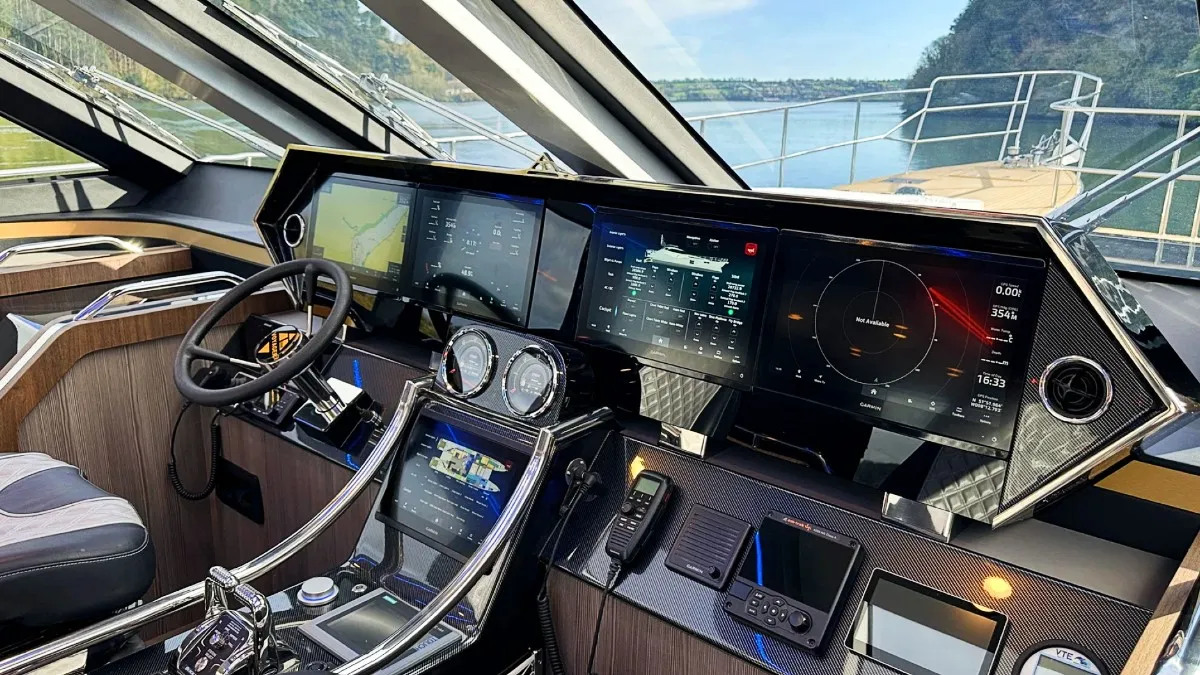
“It’s going to a client in the Middle East who plans to use it for just himself and his wife,” says Kowalski. The client has specified a full-width owner’s suite with a central, king-size bed and oversized his-and-hers bathrooms and closets in each hull. “He also wants to go fast—very fast,” Kowalski continues. “So we’ll install twin 2,000 hp MAN V12s, again with surface drives, and a central hydrofoil to reduce drag. The plan is for it to hit a top speed in excess of 100 kph.”
The new T-2000 is also designed to go the distance. With the 10,977 kilogram tanks, it has a range of more than 1,000 nautical miles at 55.2 kph, and 1,700 nautical miles at 28 kph. Throttle back to 19 kph and range increases to 3,000-plus nautical miles.
Much of this is down to the yacht’s symmetrical, semi-wave-piercing hulls, made of a carbon-fibre-composite construction, with inverted lower bow sections and a double-chine arrangement that projects spray clear of the boat. The hydrofoil in mid position also means that, at speed in calmish seas, the T-2000 rides with half its hull length out of the water.
To eliminate waves slamming into the bridge deck windshield, Kowalski moved the pilothouse farther back. It also makes for a sleeker profile, giving the T-2000 the look of a single-hull sportsyacht.
As for creature comforts, the main, open-plan salon features an L-shaped Corian-topped galley, with a U-shaped dinette opposite. To enjoy the action, there are bucket-style, shock-absorbing seats for the captain and copilot, a wraparound sofa on the port side, and a single bucket seat to starboard.
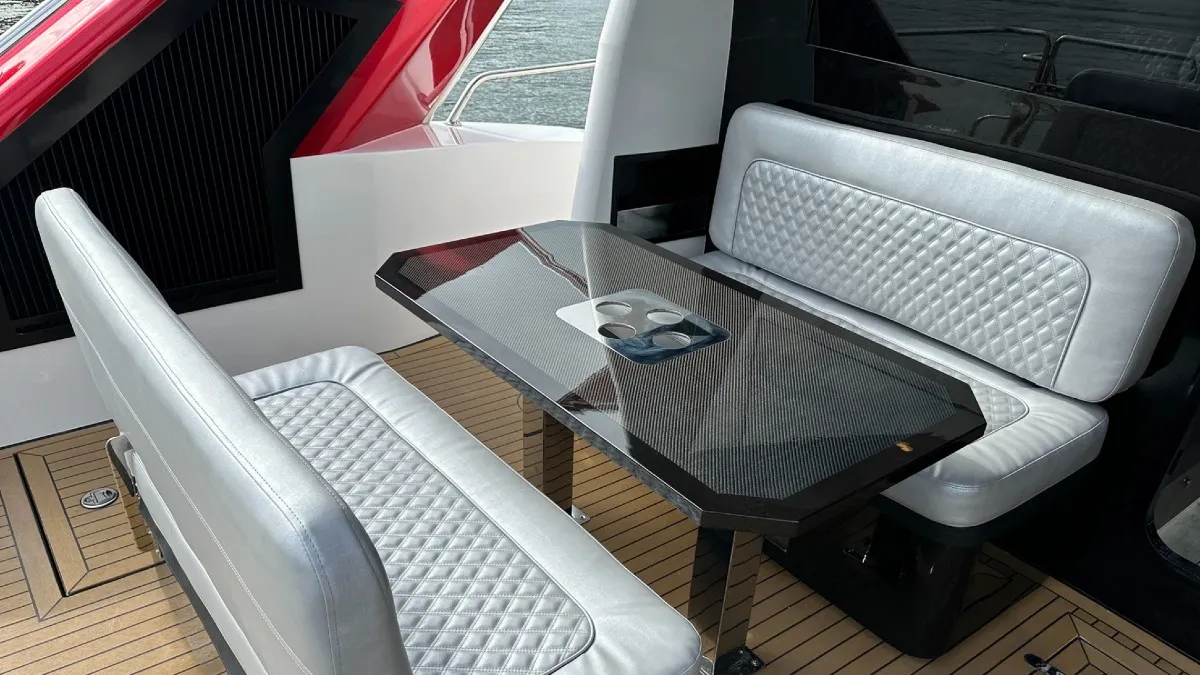
The entire helm area gets flooded with light courtesy of the four-panel, angled windshield and quartet of fixed skylights above. To see the boat’s hydrofoil in action, the bridge has a glass panel in the floor that’s also designed for viewing marine life below at night. Most of the windows have half-inch-thick toughened panels to shrug off cascading water.
In finer weather than typically found on coastal Ireland, the T-2000 has a small flybridge with a helm station and sun-lounge area up top, plus a covered stern cockpit with sofas and table for alfresco dining.
This storm-tested, metallic-red demonstrator is available for around $5 million.
You may also like.
Six Senses Are Suddenly Everywhere. Inside the Luxury Resort’s Growing Global Empire
With 26 properties now open, another 43 to come, and the U.S. square in its sights, the rapidly growing wellness-focused resort and hotel brand is now asking the hard questions
If someone hit you in the head (hard) just before the pandemic, and you’re only waking up now, in the middle of 2024, you’ll have noticed some changes. For instance, the global proliferation of Six Senses hotels and resorts.
Once a relatively quiet group of wellness-focused Asian resorts for in-the-know Europeans, Six Senses is now in the midst of a breakneck opening spree with the U.S. square in its sights. Since 2019—when hotel giant IHG dropped $440 million in cash to acquire the operator’s then 16 hotels and resorts from private equity group Pegasus Capital Advisors—it’s grown to 26 urban hotels and destination resorts in 21 countries across four continents. (Its Vana resort in India is one of Robb Report‘s 50 best luxury hotels in the world).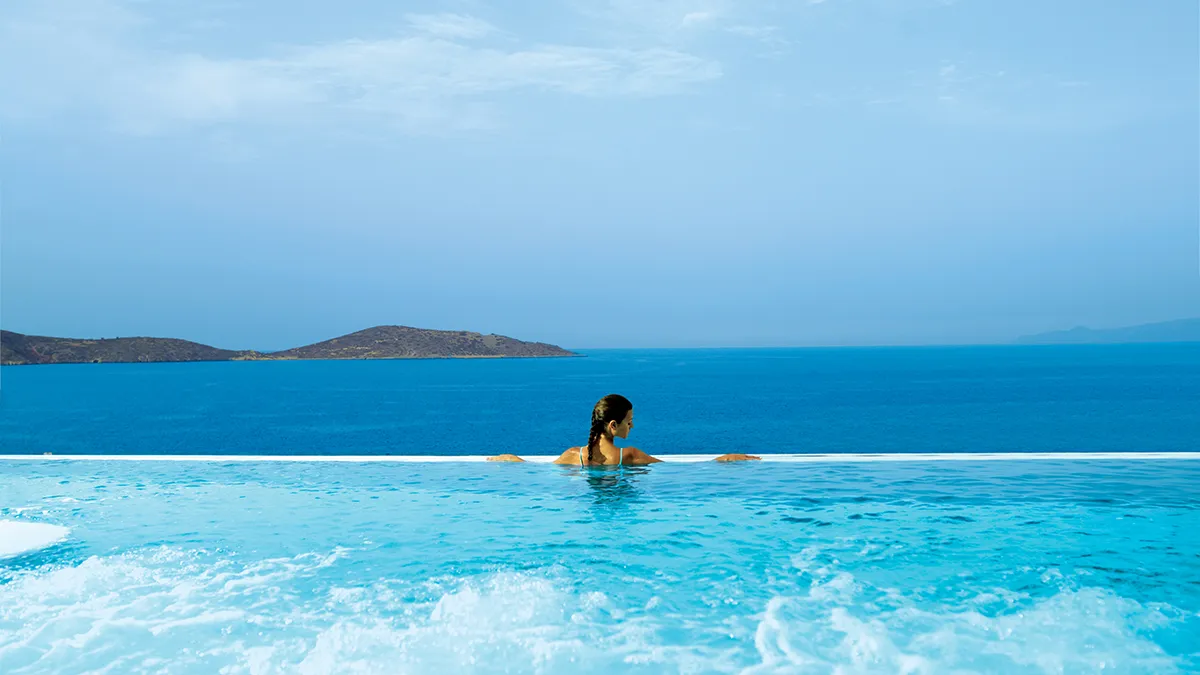
Blink again and that number may have doubled. By 2026, Six Senses, now the flagship brand of IHG’s luxury and lifestyle portfolio, hopes to have a shingle hanging in London, Bangkok, Dubai, Lisbon, Napa, and Tel Aviv. There are currently 43 Six Senses in the pipeline, which will extend Six Senses footprint from the Carolinas to Victoria Falls. Many of those new properties will come packed with branded residences.
So is Six Senses trying to conquer the world via ayurvedic medicine, longevity spa treatments, and mindfulness exercises?
“It’s been a hell of a ride,” admits CEO Neil Jacobs. “But the answer is no, and we have a real point of view on that.”
More on that point of view momentarily, but it’s worth pausing to note that despite his protestations, Jacobs comes to Six Senses with 14 years of experience with a hotel group that is arguable much more overtly interested in turning planet Earth into one massive 5-star hotel lobby: namely, the Four Seasons. As senior vice president of operations for the Four Seasons’s Asia Pacific region, he witnessed the company expand from roughly two dozen hotels into the 130-ish-address, Bill Gates– and Prince Al-Waleed bin Talal–owned leviathan of luxury it is today. The Four Seasons’s stated goal is 200 hotels. But Jacobs tells Robb Report it’s neither his or IHG’s intention to turn Six Senses into the Michael Kors of opulent wellness resorts.
“We think less is more,” he says of that aforementioned point of view. “Our competitors are all about growth. With Six Senses the conversation is very much the opposite of that. You’ve got to be really careful about what you do and where you go. I mean, we started with eight resorts in 2012. Then there were 11, and we got rid of two or three. Today, there are 26. So we’ve only opened 18 in nearly 12 years, really.”
Still, the Bangkok-based company is hurtling toward 60-plus properties, a number Jacobs says he is “comfortable” with. What happens beyond that is stickier.
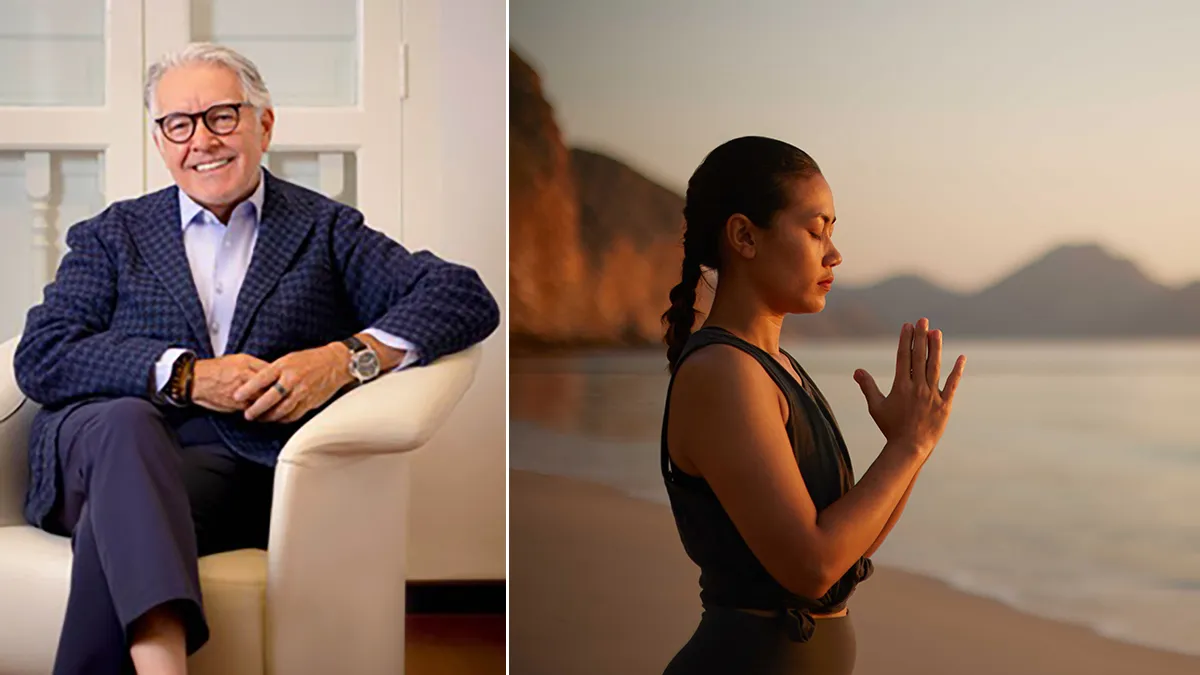
“We have four projects in Italy. We could do another five, but why?” says Jacobs. “Instead, let’s move to another country and spread, rather than just inundate the brand in one country, even though there’s places to do it. It’s a continual argument internally. We have some great places coming to Italy, but we don’t have Venice. So then my team says, ‘If we have a Venice deal, are you going to say, ‘Don’t do it?’ Good question. But the answer is, ‘maybe.’”
Whether it’s Six Senses, the Four Seasons, or Auberge (another brand that has seen a similarly rapid expansion), the answer to the question “When does quantity extinguish the spark of quality?” is worth at least a billion. But it’s also a problem that highlights the welcome fact that, despite the current slump, “luxury” is winning; it may have already won.
From fashion to travel, a growing share of businesses have repositioned themselves to serve the high-end consumer, as growing global wealth supports superior margins realized through the relative simplicity of a luxury rebrand. The affordable family resort of yesterday becomes the aspirational seaside playpen of today. As long as demand for luxury everything is here, deep-pocketed hotel groups will grow to meet it.
At the same time, the success of “luxury” creates a clear existential dilemma: If luxury becomes the standard setting, it is by definition no longer an indulgence, no longer a luxury. And as luxury becomes more gray and undifferentiated, the vague, eye-of-the-beholder quality that was once its strength, is now its liability.
It’s a problem that Jacobs feels that Six Senses was uniquely designed to address.
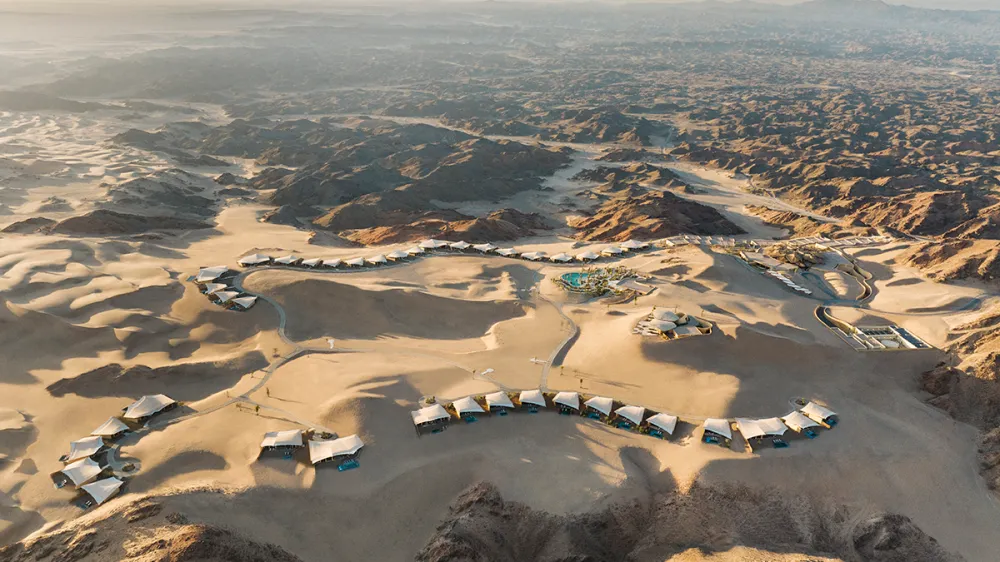
“That sixth sense in our name, we see it as intuition,” he says. “It’s interesting because one of our initiatives for this year in wellness is spiritual wellness. In the past, we’ve done a lot of yoga, we’ve done a lot of meditation, but we haven’t done a lot of overtly spiritual programs. We think the time is right.”
Those programs serving up, non-religious, lightly-woo spirituality on a silver platter roll out later this year and offer a key differentiator for the brand’s fastest growing customer base: Americans.
“Back in 2012, it was predominately a European customer, I’d say 85 percent,” says Jacobs. “There was no business coming from the U.S. Today, the U.S. is our number market, even though we don’t have anything open in the U.S.”
It’s not for lack of trying. Six Senses planned to open in Manhattan along the High Line in a doomed Bjarke Ingles–designed tower that was crushed by a Gambino crime family construction bribery scandal and the subsequent bankruptcy of its developer. Six Senses has since found a new site on 23rd St. between Seventh and Eighth Aves. in Chelsea, but is at least three years out.
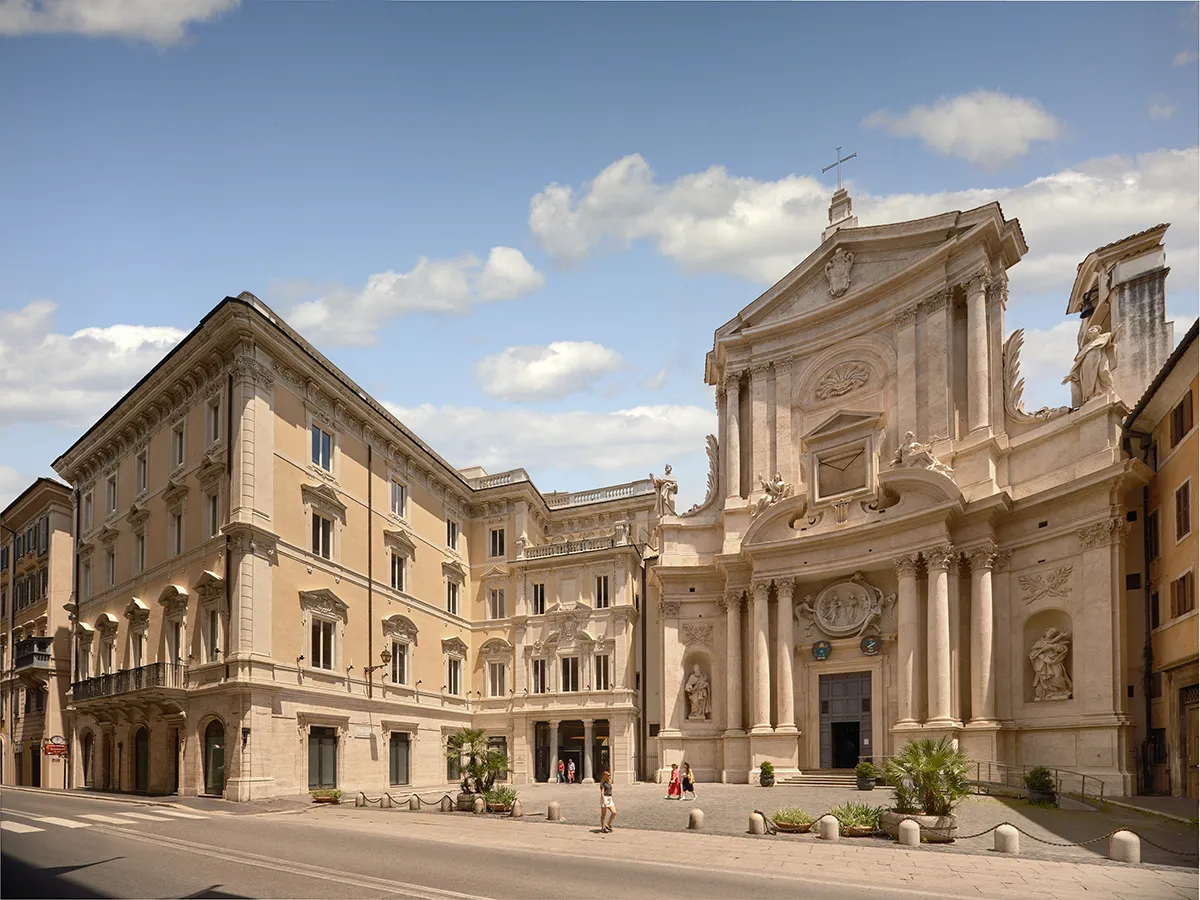
It’s having a better, if not altogether easier, time with the 236-acre farm in Hudson Valley in Upstate New York. The site of a failed “secret hotel” project, Six Senses snatched up the land for $20.2 million in 2022, making it some of the only real estate the brand owns (as with many brands, outside investors typically carry the deeds). Although it would be the first five-star flag in the region, the project has faced community opposition that could scuttle yet another attempt to create a footprint in the U.S.
“I don’t think it’s going to work,” Del LaMagna, whose property shares a border with the site, told the Hudson Valley Pilot. “[IHG] decided they wanted to be here, they started hiring good local people to figure it out, but this whole idea of exclusive resorts for rich people just doesn’t work up here.”
That’s a matter of opinion, but Six Senses plans for the U.S. extend far beyond the town of Clinton. Besides urban hotels in New York, L.A., and Miami, it will open a series of resorts, starting with a 500-acre estate on the edge of Napa and a multi-island project off the coast of South Carolina spanning Hilton Head, Daufuskie, and Bay Point. The gargantuan scale of those properties will eventually facilitate the festivals and retreats that the brand has been recently investing in.
“It’s a lot of yoga, a lot of spirituality, a lot of fun, a dance, a lot of movement,” he says. “Those kinds of festivals resonate with people.”
So if you’re just waking up, welcome to a world where Six Senses is everywhere all at once. But Jacobs hopes that by selecting “extraordinary properties” and by “demonstrating our values in a highly meaningful way” that the resorts will fit into the ecosystem like redwoods in a pine forest. Call it a sixth sense.
You may also like.
Rolls-Royce Debuted the New Phantom Scintilla at Monterey Car Week. Here’s Everything We Know.
Limited to 10 examples, each car has an interior defined by “painting with thread,” and a rumored price of around $2.6 million.
Visitors to the fabled Louvre Museum in the heart of Paris might remember an exquisite marble sculpture standing proud at the top of the main Daru staircase. Named the Winged Victory of Samothrace, this eight-foot-tall headless goddess—with gossamer wings—dates to 190 B.C.
What has it got to do with Rolls-Royce’s new Phantom Scintilla Private Collection limousine, unveiled during this year’s Monterey Car Week? A lot, in fact. Rewind to 1910 and Rolls-Royce’s managing director at the time, Claude Johnson, who reportedly commissioned well-known sculptor Charles Sykes to create a hood ornament to define the new Rolls-Royce brand. Apparently, Johnson had seen the statue during a visit to the Louvre and fell in love with it.
While a change in direction saw Sykes create the Spirit of Ecstasy, inspired by Johnson’s former secretary, English actress and model Eleanor Thornton, the Louvre statue was always considered by Goodwood to be the original inspiration for its now iconic emblem.
So, when Rolls-Royce designers looked for a muse for a 10-car, Phantom-based Private Collection series to be called Scintilla—derived from the Latin word for “spark”—the marque went back to the Winged Victory of Samothrace statue and its Mediterranean roots.
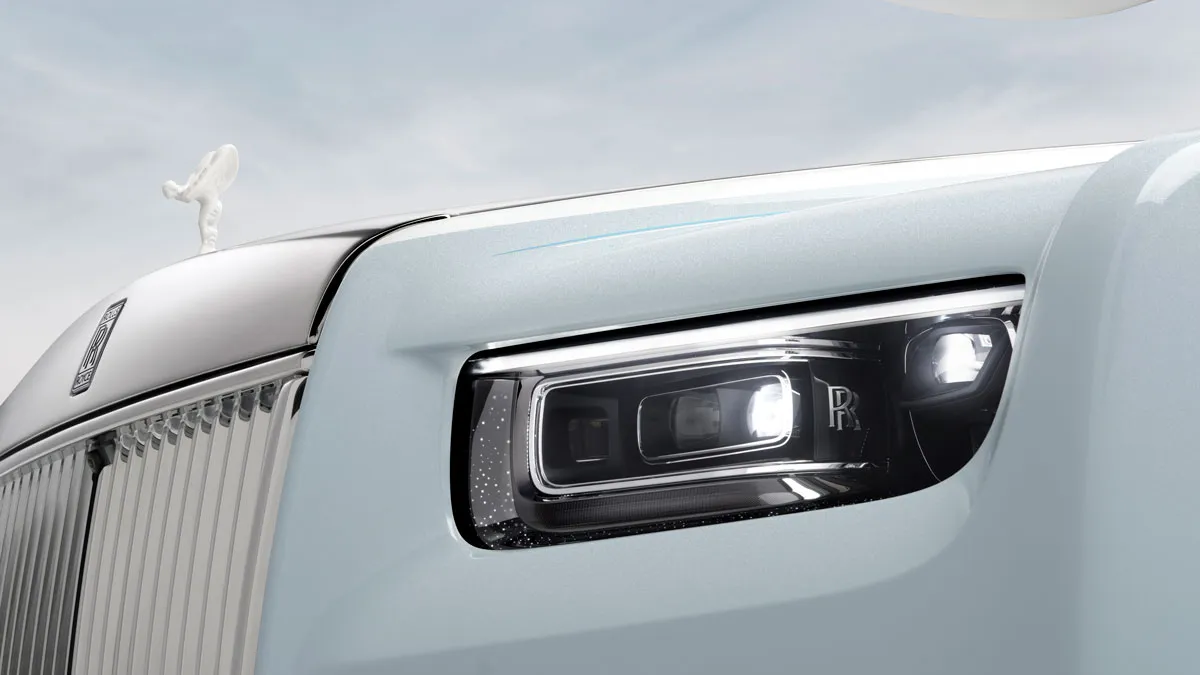
You see that influence in the car’s Spirit of Ecstasy figurine which, for the first time, features a translucent white, marble-like ceramic coating. It also carries over in the car’s two-tone paintwork—Andalusian White for the upper body, and powdery Thracian Blue, inspired by the color of the Med, for the lower section. A subtle metallic flake in the paintwork is said to mimic the sparkle of sunlight off the water.
Yet as with most bespoke and special-edition Phantoms, it’s the interior where Rolls-Royce craftsmanship is truly exhibited. In this case, the theme is exquisite embroidery or, as the automaker calls it, “painting with thread.”
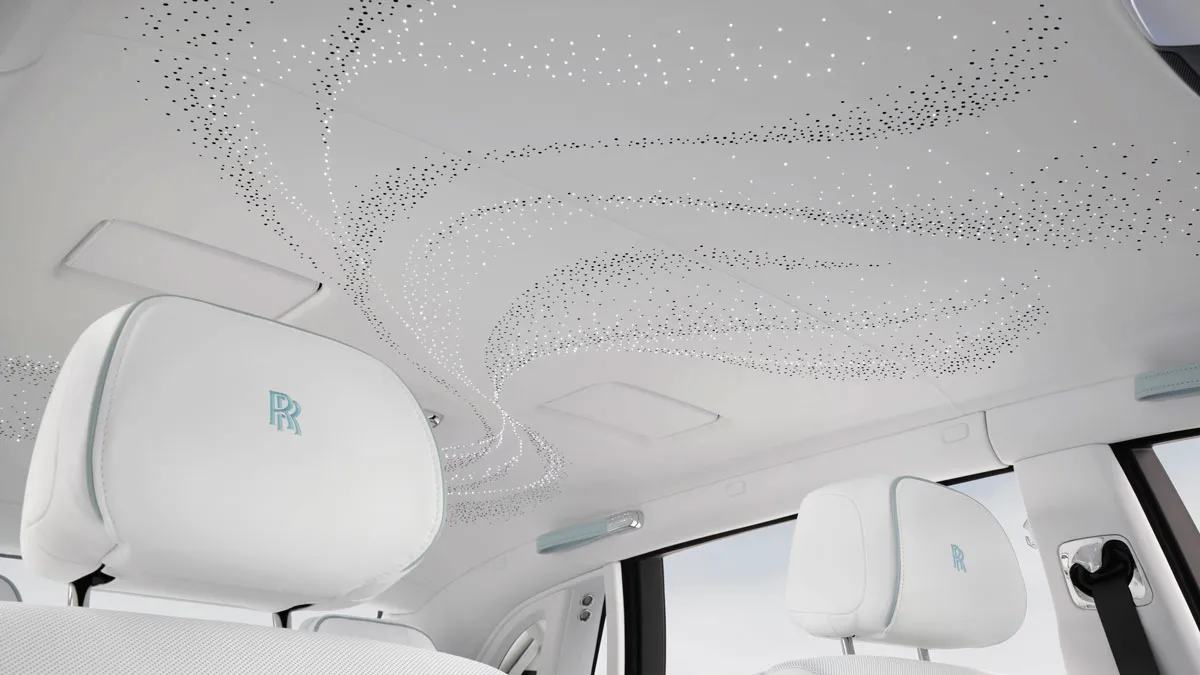
For Scintilla, the embroidery work involves over 850,000 individual stitches. And at night, illuminated perforations in the material give the doors a wave-like glow. In Phantom tradition, there’s a Starlight Headliner in the roof, but here, more than 1,500 fiber-optic illuminations twinkle in sequence to mimic silk billowing in a breeze.
The centerpiece of the interior is the Phantom’s dashboard gallery ahead of the front-seat passenger. Named “Celestial Pulse,” it comprises seven metal ribbons, each individually milled from solid aluminum and given the same finely grained ceramic finish as the Scintilla’s Spirit of Ecstasy.
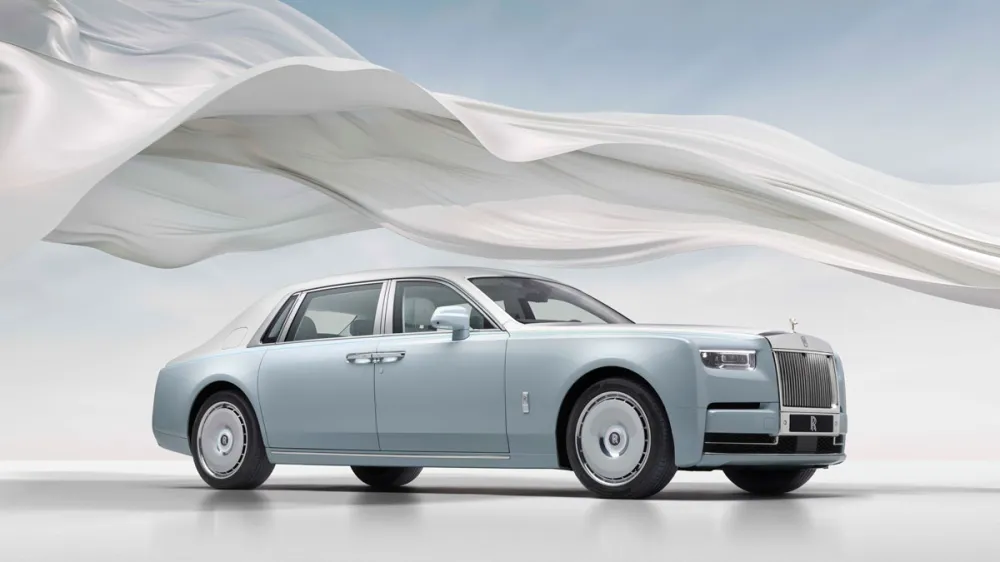
Rolls-Royce will build only 10 examples of the Phantom Scintilla, which had its public debut at the Quail, a Motorsports Gathering on August 16. Of that already small number, three will come to North America and, like the other seven, have already been sold. While there’s no official word on pricing, the figure $3.8 million has been reported.
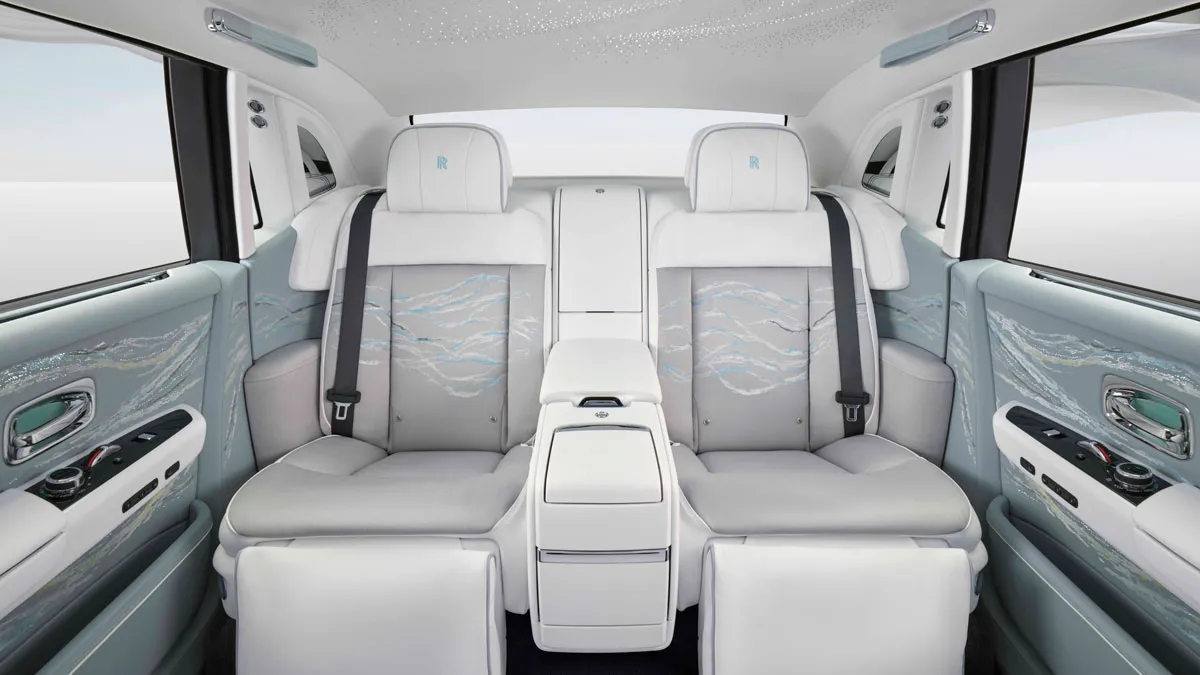
“With every collection, we aim to tell the story of Rolls-Royce Motor Cars and provoke our clients’ imagination, letting them know our Bespoke designers’ artistry is greater than they can envision,” stated Martin Fritsches, president of Rolls-Royce Motor Cars for the Americas, when asked for a comment by Robb Report. “We can’t think of a better way to tell this story than through the history of our idol, the Spirit of Ecstasy.”
You may also like.
Astonishing Nature, At Its Most Magnificent
Scenic Eclipse hones 6-star ultra-luxury around Antarctica’s raw nature.
Picture this. You’re sitting at the Sky Bar on the Scenic Eclipse II. It’s freezing outside, but you’re warm and dry, sipping a delicious glass of pinot noir as you watch a colony of penguins play on the ice sheet. Is this a dream? Or just another incredible moment from the 6-star ultra-luxury discovery yacht Scenic Eclipse?
It may sound too good to be true, but Scenic has over-engineered their two major Polar ocean-going vessels (Scenic Eclipse & Scenic Eclipse II) to offer up mind-blowing opportunities to connect to untouched nature. While the White Continent continues to hold pride of place on most people’s bucket list, few will ever experience it in such refined style.
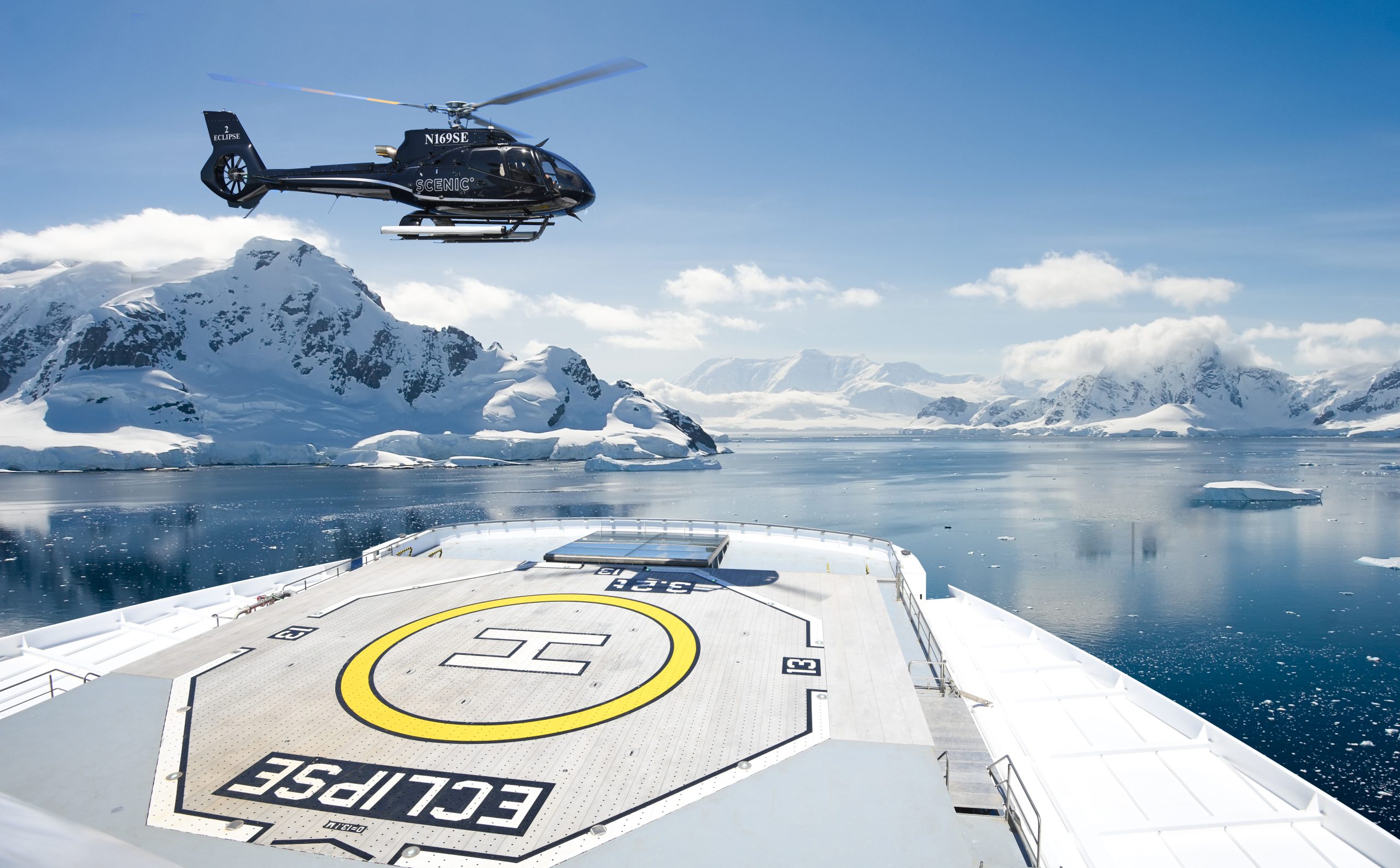
With just 200 guests on board in Antarctica for more landing opportunities, Scenic has decked out their vessels out with 6-star hotel facilities, and equipped them with luxury tech toys to satisfy even the most restless traveller.
They offer an impressive close to one-to-one staff-to-guest ratio, up to 10 dining experiences , as well as two state-of-the-art on board helicopters^, Zodiacs and a custom-built submersible^ for further discovery in the destination. Paddle boards and kayaks are deployed regularly (conditions permitting), and guests are provided with polar boots for land-based snow treks.
This is not a floating hotel but a discovery yacht for the discerning traveller. Daily plans are shaped around the weather and sea conditions. A typical day can include a leisurely breakfast and visit to the 550sqm Senses Spa#, morning and afternoon discovery excursions, lunch in your venue of choice or in your suite, and a delicious on board culinary experience for dinner before heading to your spacious suite with verandah to unwind.
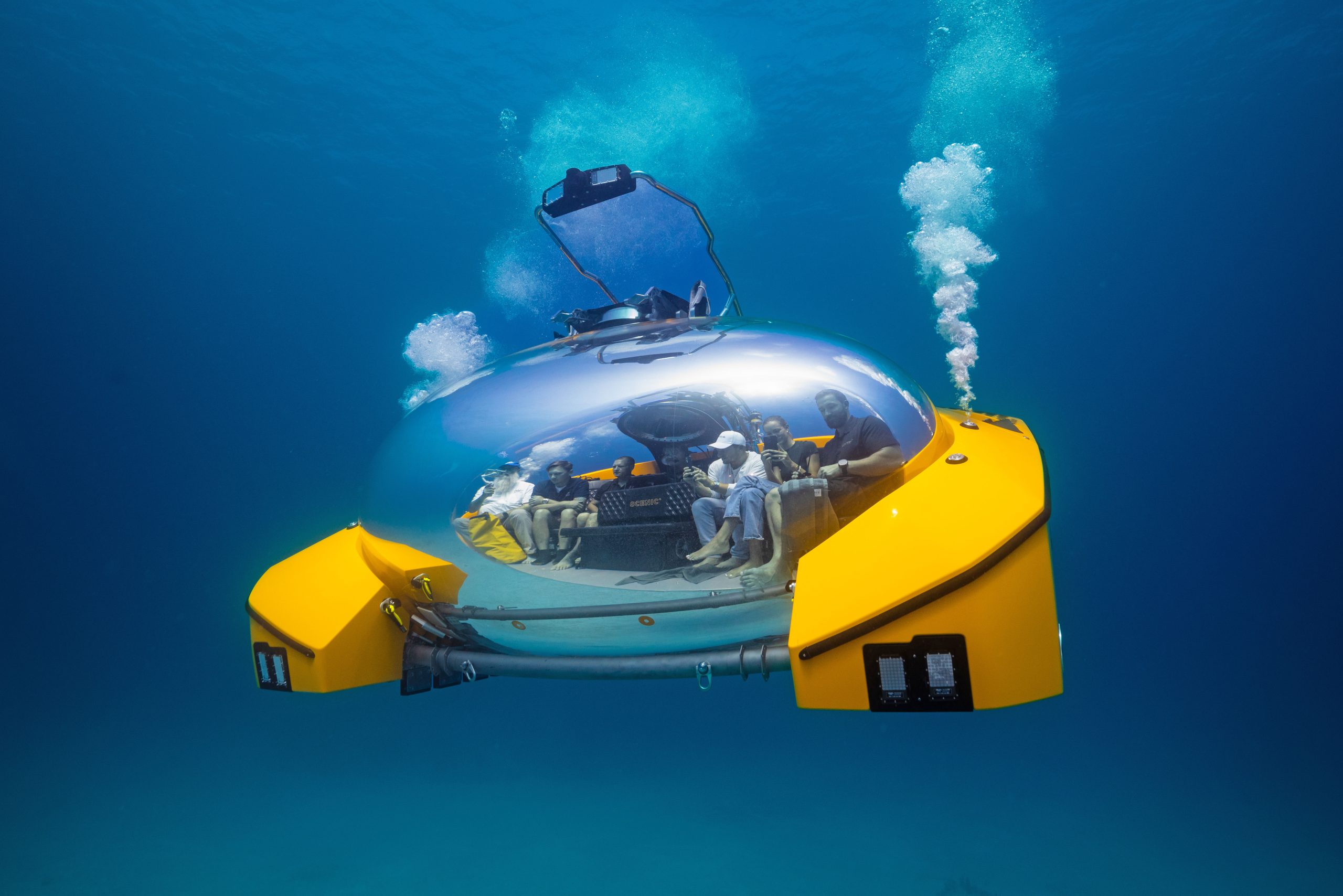
When not out with the expert polar Discovery Team relax in the Observation Lounge or indulge in a sauna and massage in the 550sqm Senses Spa# wellness retreat. For your daily entertainment there are whales, penguins, orcas and seals to observe and document.
The two major trips that depart for East Antarctica from our part of the world in the next several months are Mawson’s Antarctica: Along the East Coast, which leaves from Queenstown, New Zealand in December and Antarctica’s Ross Sea: Majestic Ice & Wildlife which leaves from Dunedin in January 2025.
The first itinerary celebrates one of Australia’s national heroes, Sir Douglas Mawson, who occupies a place on the $100 note. This itinerary allows guests to follow in the footsteps of this intrepid explorer, retracing his travels across the continent in the name of scientific research. The trip takes in remote bays and ravishing coves, placing guest in breathtaking landscapes where wildlife reigns supreme.
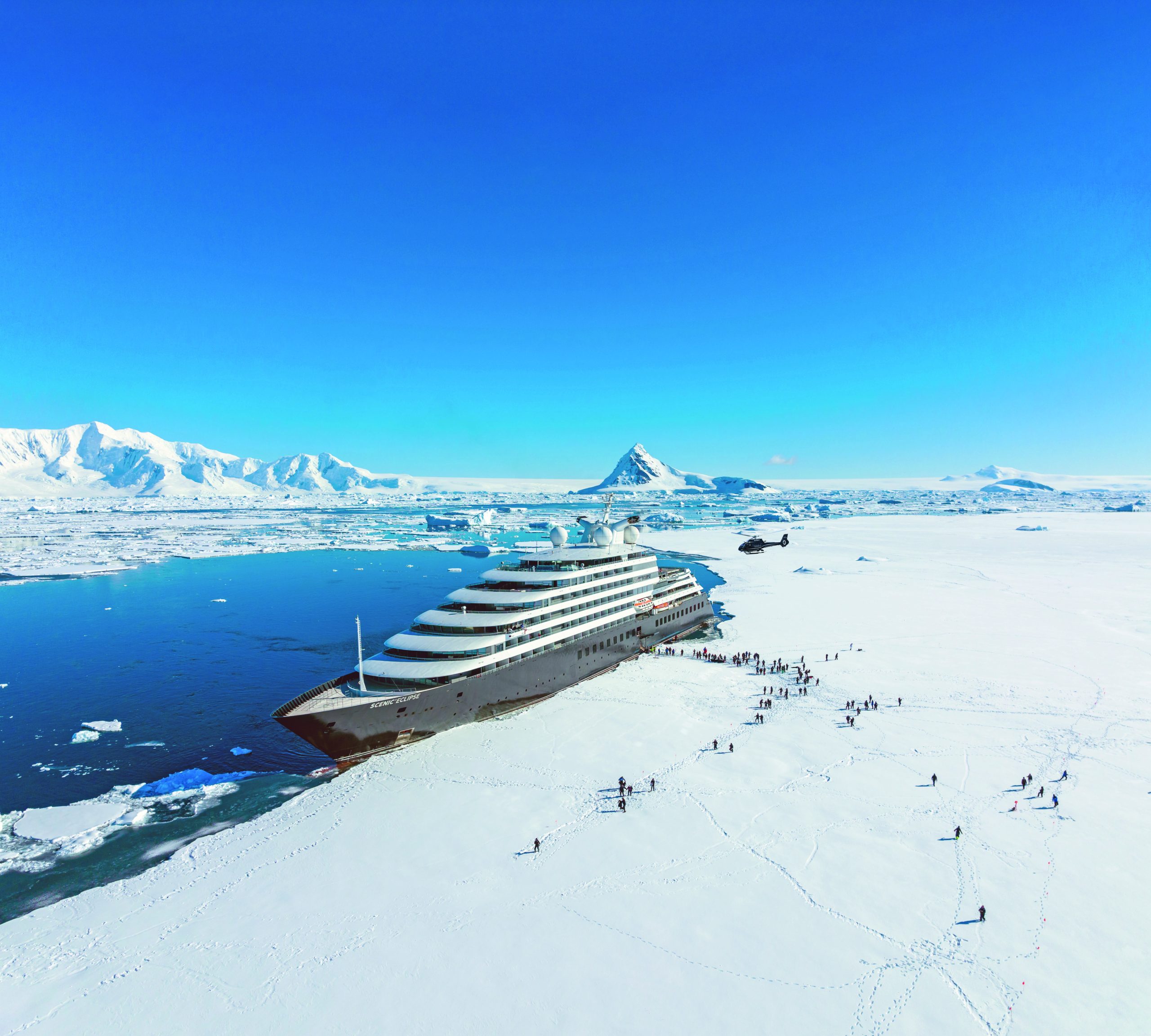
Led by the expert polar Discovery Team, guests can also opt to dive below the depths of the polar waters in the custom-designed submersible Scenic Neptune II, or take to the skies in the two on board state-of-the-art helicopters (for an additional cost). Guest on this voyage will enjoy a heli-shuttle directly from the discovery yacht to view the remains of Mawson’s Hut. The Mawson 25-day all-inclusive itinerary departs from near Queenstown to Hobart on 15 December 2024 and 13 December 2025 and is priced from $39,270pp* with savings of $13,000pp* and a 50% off the Deluxe Verandah Suite upgrade.
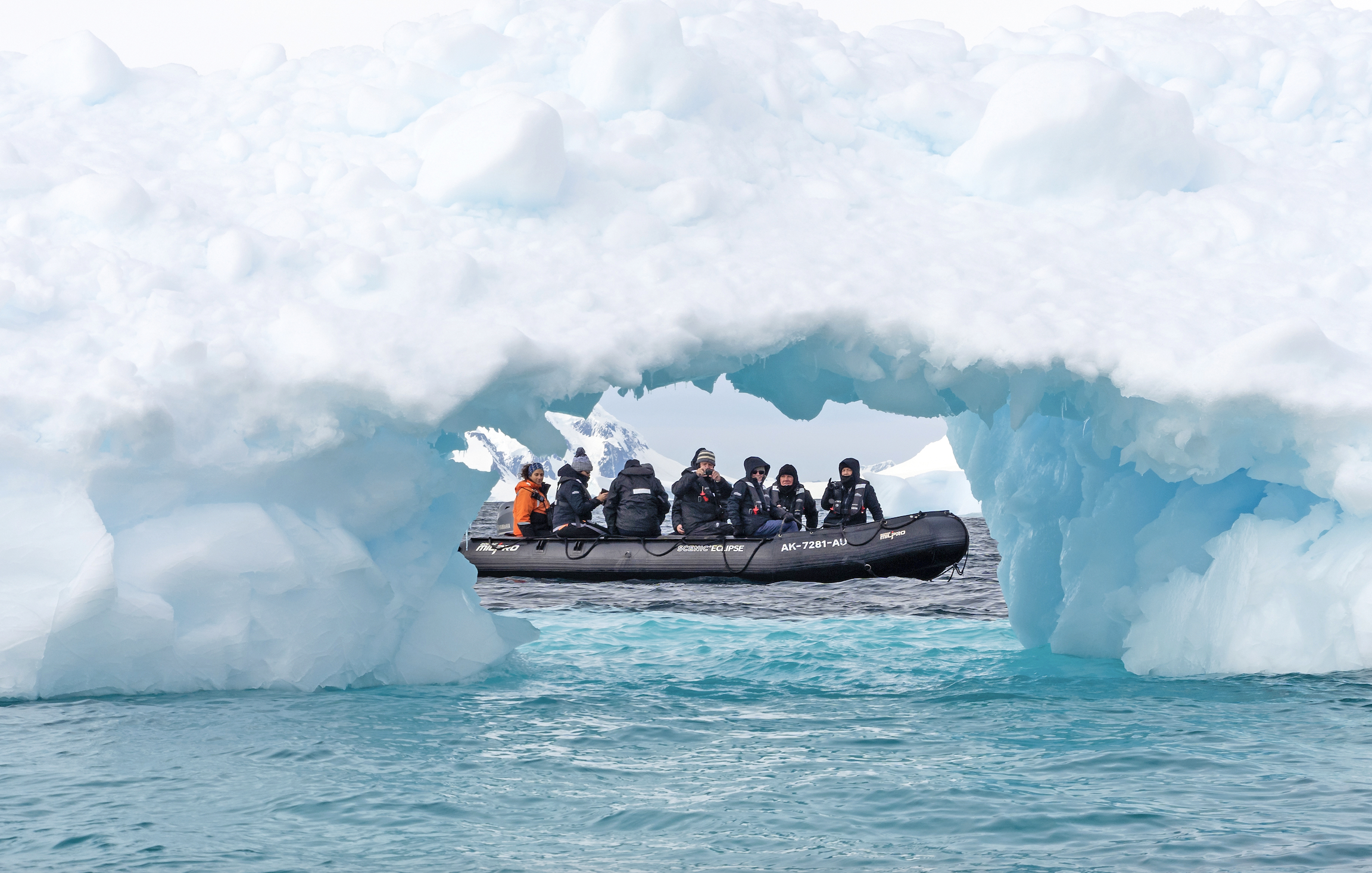
The Antarctica’s Ross Sea: Majestic Ice & Wildlife is voyage of a similar length, 24 days, but here the journey has a very end-of-the-earth feel to it. Striking ice landscapes offer vistas of gem-like glaciers, views to towering icebergs and jagged mountain ranges that form the backdrop to epic wildlife displays.
For nature lovers, the Ross Sea represents a holy grail, one that’s absolutely teeming with whales, orcas, penguins, seals and migratory seabirds. Day trips and land excursions here are all crafted in response to weather, by the expert polar Discovery Team and Captain who know the terrain.
These are side trips and excursions that are well designed to take advantage of the close access to truly life changing experiences and each one is a show-stopper.
Once again guests can opt to book the helicopter^ excursion for an extra cost to fly off and land in the McMurdo Dry Valleys, a place like no where else on earth where the snow is void or take a dive in the submersible^ to see what lies beneath.
This all-inclusive ultra-luxury, 24-day itinerary, departs from Dunedin, New Zealand on 31 January 2025 and 29 January 2026 and the voyage starts from $38,970pp* with savings of $13,000pp* and a 50% off the Deluxe Verandah Suite upgrade .
To learn more, visit: scenic.com.au
*Terms and Conditions apply.
^Flights on board our two helicopters and submersible experiences are at additional cost, subject to regulatory approval, availability, weight restrictions, medical approval and weather, ice and tidal conditions.
#Spa treatments at additional cost.
You may also like.
The Small Dress Watch Is Back
Drawer the Daytona—a small, slim dress watch is the discerning wristwear of the moment.
For the first time in decades, dress watches—from simple, three-hand Patek Philippes to flamboyant Cartiers—are running circles around sports watches with regard to both desirability and style.
“In terms of taste, things have changed,” says David Hurley, deputy CEO of the Watches of Switzerland group, a retailer with 30 multi-brand and 25 mono-brand partnership stores across the U.S. While until recently demand “was all about the steel sport timepiece, ” he says, “now we’re seeing dress watches and brands such as Jaeger-LeCoultre”—long esteemed for its formal models—“performing well in our stores.”
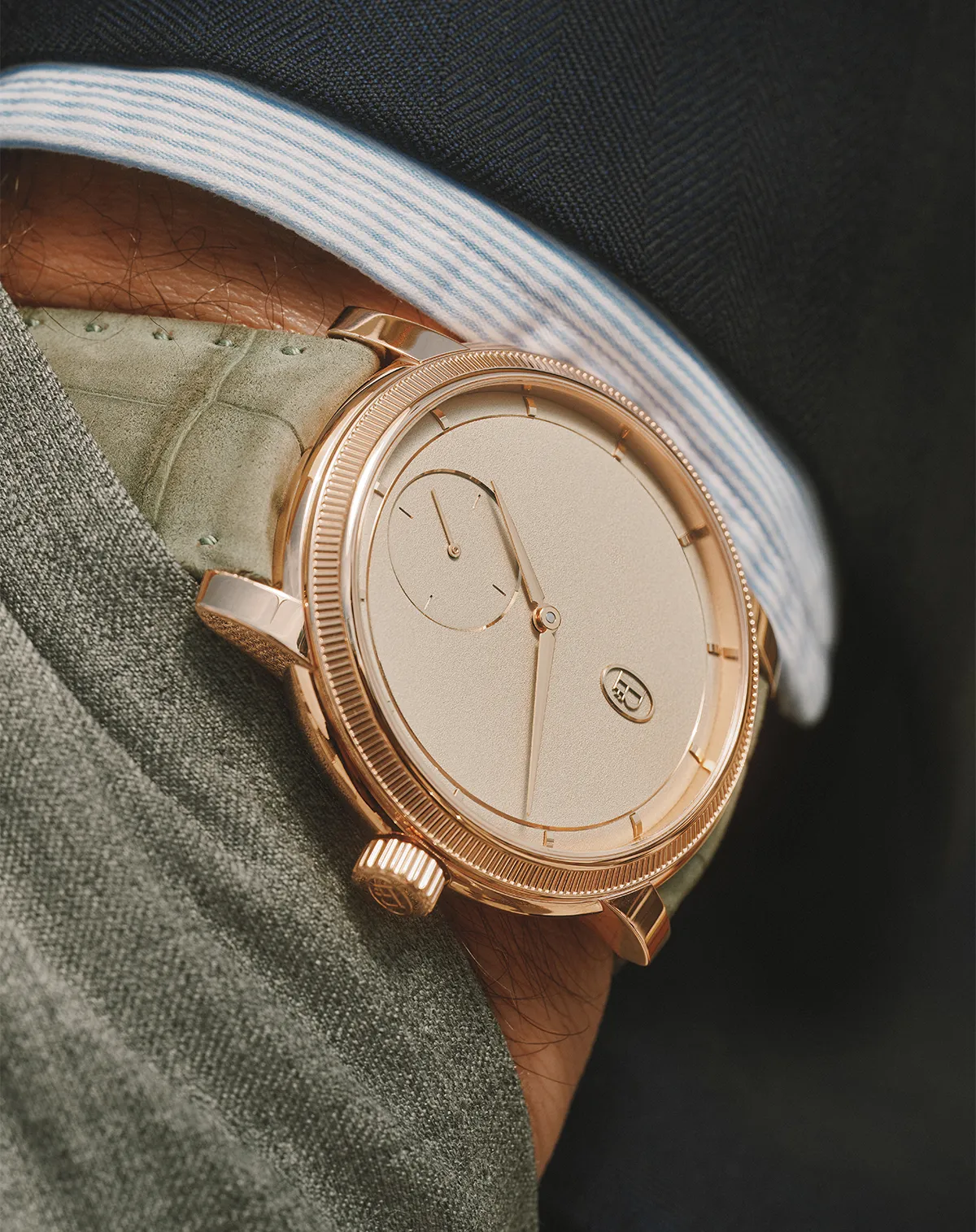
The genesis of the shift dates back to the early days of the pandemic, when secondary prices on blue-chip sports watches such as the Rolex Daytona, Patek Philippe Nautilus, and Audemars Piguet Royal Oak began clocking staggering monthly increases; by early 2022, some pieces were fetching five times retail value. Then, in May of that year, the crypto collapse triggered both a decline in secondary-market values and an exodus of speculators who were only in the game to make a quick buck. Genuine enthusiasts who had been lured to sports models by the prospect of a rapidly appreciating asset were also free to return their attention to timepieces that better reflected their tastes.
“People who got priced out of these sports models suddenly realised they could go into a Patek Calatrava at retail price,” recalls Eddie Goziker, president of the pre-owned dealer Wrist Aficionado. “The market pushed them in that direction. And once they got there, they saw the value in it and stayed.”
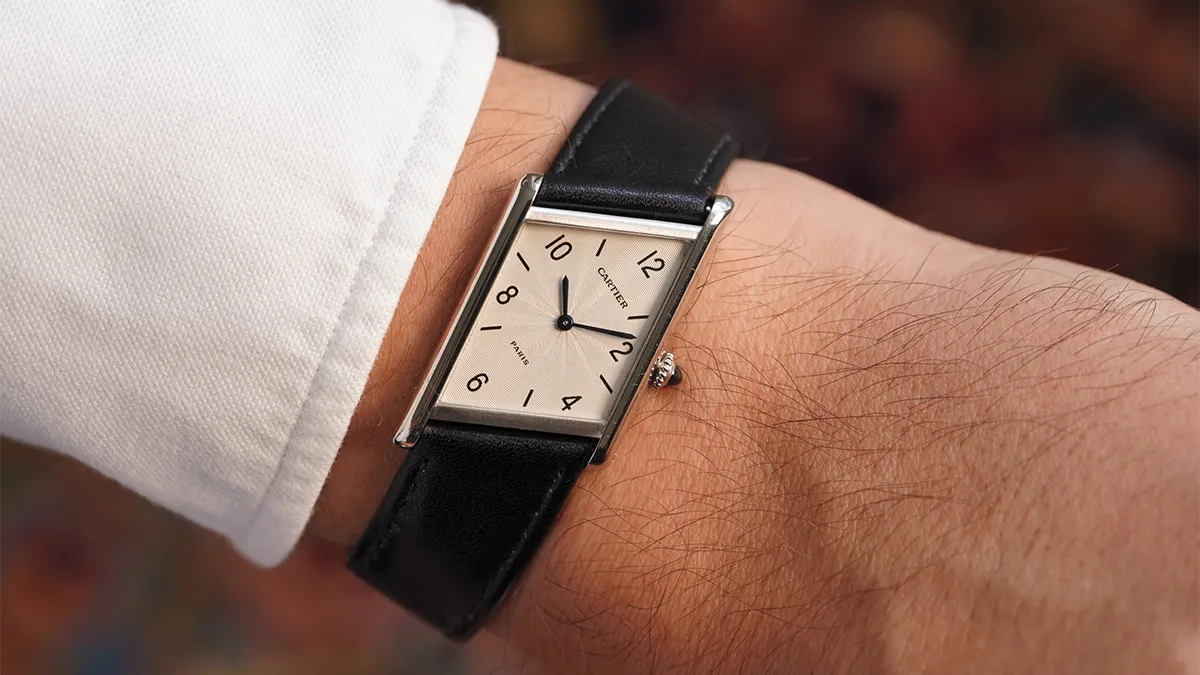
With the vogue for smaller cases already in full effect, the clamor for slim, classic styles presented on a leather strap is now at a crescendo, according to vintage dealer Mike Nouveau. “The Patek 96, the first Calatrava ever, is 30.5 mm, and they made that watch for 40 years,” he says. “I’m buying and selling them like crazy, both for my personal collection and for clients.”
“There’s a ton of interest in Calatravas, vintage Vacheron Constantin, obviously Cartier,” says Eric Wind, owner of Wind Vintage in Palm Beach, Florida. “The steel sport watches used to be an ‘if you know, you know’ watch,” he says, explaining the aesthetic about-face. “The Nautilus 10 years ago used to be unknown. Now everybody on the planet knows what it is.”
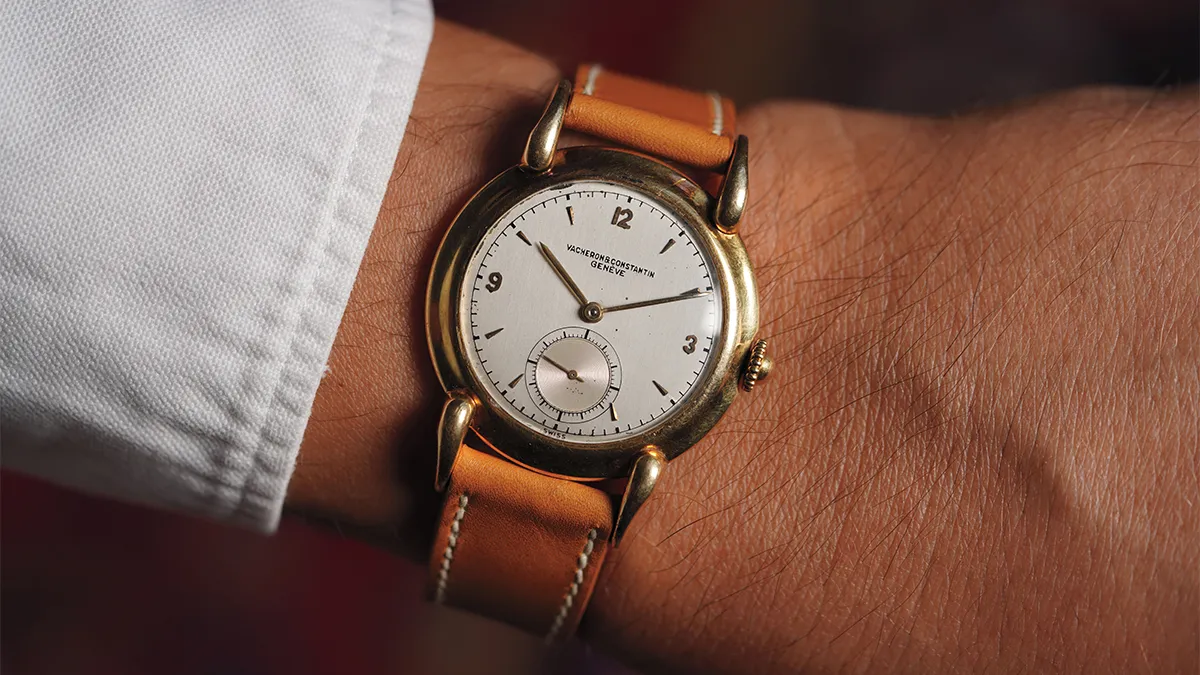
And that, he notes, includes thieves, further helping the trend toward smaller, simpler, more discreet timepieces. “I know two people who had Patek Aquanauts stolen off their wrists, and another client had a gold Rolex Day-Date stolen in Brussels,” Wind says. “People don’t have the same connotation if you’re wearing an old dress watch—it’s more of a quiet luxury.”
But in the enthusiast world, of course, the quietest luxury can also be the loudest flex, and for dress watches, that includes the strap. Wind notes that bands by Paris-based leather-goods maker Jean Rousseau are afforded particularly high status. “A baller move is getting a Jean Rosseau with a single punch, just for their wrist,” he adds.
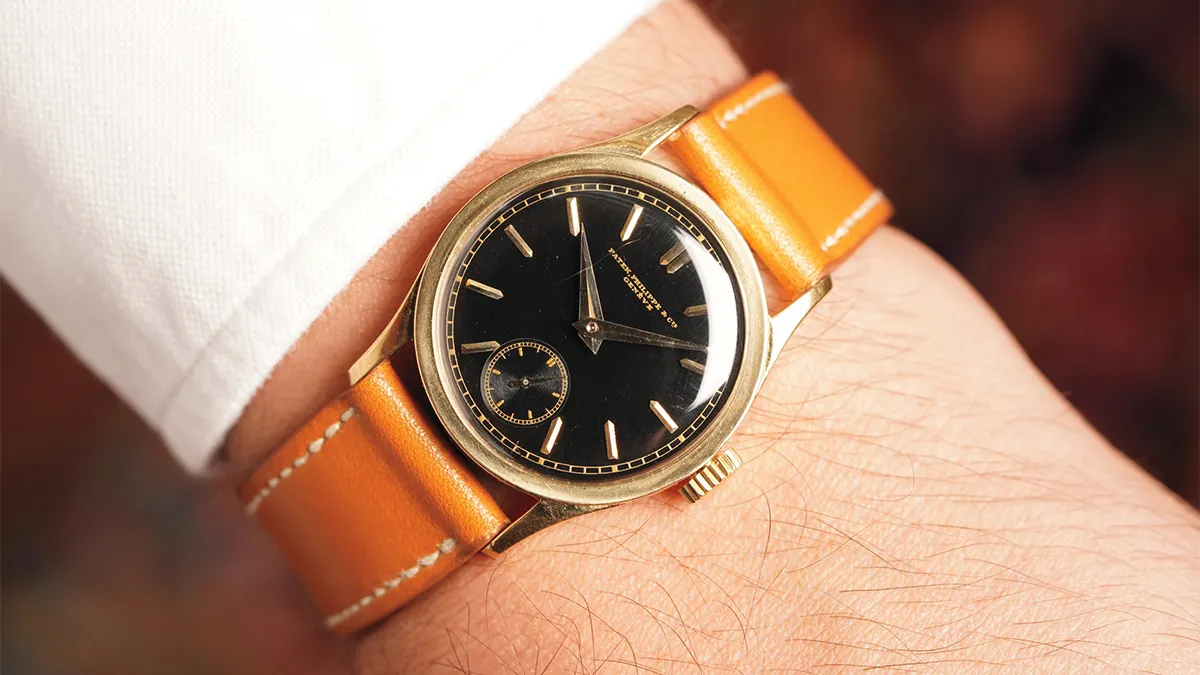
And the tremendous breadth of dresswatch designs, from simple three-hand models to ultra-complicated wonders, is a boon for collectors. If your tastes run to sober, sophisticated German watchmaking, a Saxonia by A. Lange & Söhne is just the ticket. A devoted minimalist? You can’t go wrong with the latest Toric collection from boutique maker Parmigiani Fleurier. Fans of more obscure brands would do well to consider the Patek-inspired (and typically sold-out) timepieces by Kikuchi Nakagawa, in Tokyo. Nouveau, for his part, recommends vintage Piaget and Breguet.
Even traditionally sporty brands are getting in on the action. At the end of May, Audemars Piguet introduced the [Re]Master02, a minimalist, asymmetrical homage to a 1960 model, from its extra-thin hour and minute movement to its matte-blue alligator strap, that’s on trend for the current dress-watch moment.
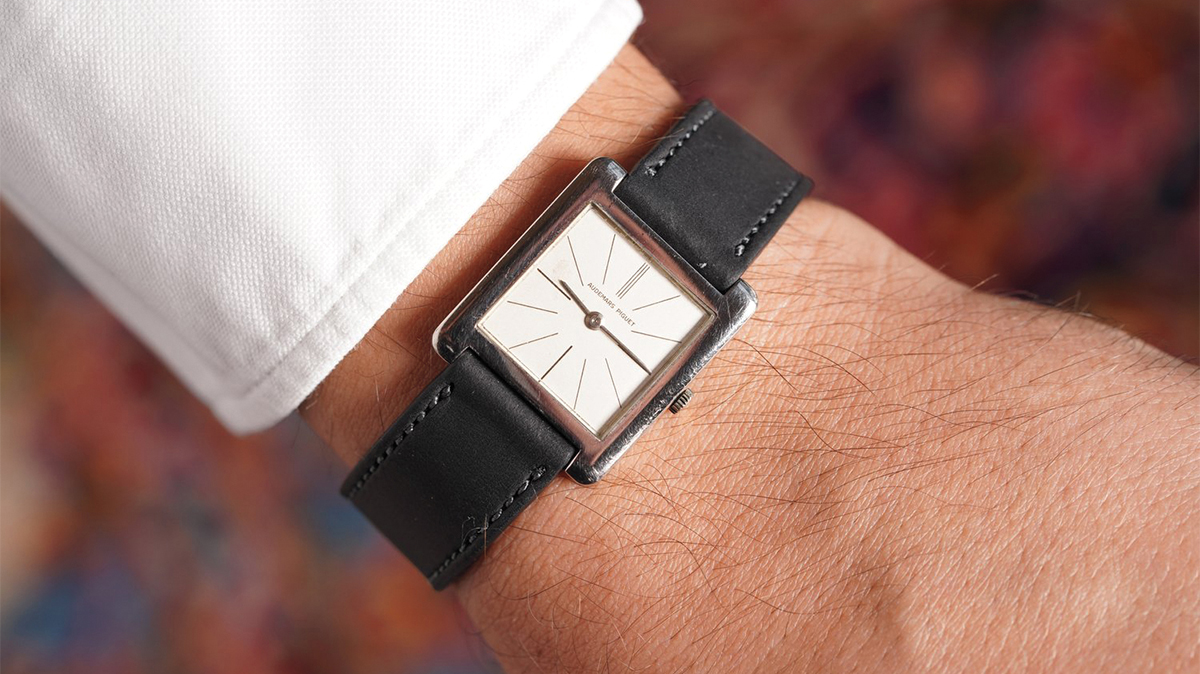
For yet more proof, consider Rolex’s increasing emphasis on its new 1908 Perpetual collection. Introduced in 2023 and expanded earlier this year with a 39 mm platinum model featuring an ice-blue guilloche dial and a brown alligator-leather strap, the 1908 is as sophisticated and gentlemanly as the brand’s iconic sports watches are rugged.






